#reading these series concurrently at the moment is an experience
Explore tagged Tumblr posts
Text
Interesting how often the Aubrey-Maturin and Hornblower series are compared when to me the vibes couldn't be more different... Reading the Aubreyad feels like a rejuvenating hang out experience with your best friends but reading Hornblower feels like working as an underpaid psychiatrist watching helplessly as your patient with every mental problem ignores all your advice and takes none of your prescriptions and digs himself into a hole deeper than you even knew was possible
#reading these series concurrently at the moment is an experience#every health point i gain from an aubreymaturin book i immediately lose when i return to hornblower's sick and twisted mind#but yet i think i still like hornblower more -_- though i'm into the (chronologically) later books now and he's just pissing me off lol#aubreyad#hornblower
271 notes
·
View notes
Text

moment from Nothing in the World fic series that I cant stop thinking about
Note: Happens in both Any Other Name ch. 56 (Izaya's pov) and Protest Too Much ch. 55 (Shizuo's pov). Highly recommend you read both concurrently to experience both povs 😊
#shizaya#shizuo heiwajima#durarara#drrr#tastewithouttalent's Nothing in the World#i would pass out on the spot ngl
217 notes
·
View notes
Note
Do you have any good sans/sans long fic recommendations? Papyrus/papyrus and papyrus/sans is good as well
If you go on AO3, you'll find there are 895 undertale fics that have wordcounts over 100,000 words. I generally consider that a longfic. Of those, 101 are tagged Sans/Sans, 18 are Papyrus/Papyrus, and 47 are Papyrus/Sans. Of those, I have only read a very very small fraction, and remember even less because I have terrible memory.
I can rec my fics or fics others wrote that I read that match this...
Kam's Recs as of 2023
Recs I Wrote:
The Ebott is a Multiverse series is currently over 320,000 words long, stretched across 7 fics of varying length. The bulk of that is stuffed into Part 2: Burlesque, a Dancetale Sans/Underfell Sans/Underlust Sans poly fic sitting at a whopping 242,709 with the latest update (chapter 54). The series is as of yet unfinished, as Parts 2, 5, and 7, which occur concurrently in the timeline, are still ongoing. You'll find, alongside the aforementioned and other skeleton centric ships, Sans/Underswap Sans, Fellswap Papyrus/Underswap Papyrus, Underfell Papyrus/Underpatch Sans, and Dancetale Papyrus/Fellswap Sans throughout the series, a different ship being the focus of each installment. Part 1 and Part 5 are consecutive, and technically focus on the same ship. The Anthology (Part 6) has multiple ships in it, but its a bit messier and jumps around. Overwhelmingly romance focused, domestic, and feel-good themes, but mind the tags in some places.
My oldest Undertale fic, Resonance, is finished at 241,287 words. There is a concurrent sub-fic with extra scenes in it too. It has several different kinds of ships in it, as I was experimenting, which include Sans/Sans and Sans/Papyrus, and I like to think one of the big important ships is Underfell Sans/Underlust Sans, but the story's focus is action based rather than romance based. It's a Dead Dove so really read through all those tags and don't eat things you don't like.
Recs I Read:
Part on of Mercy_Run 's KR Trilogy is called Karmic Retribution. It's 127,905 words and the ship is Sans/Underfell Papyrus/Underfell Sans. It has been a while since I read it, but I remember it takes place underground in Underfell after classic Sans is displaced there. It was one of my first reads when I got in the fandom and I think it had a formative influence on me <3
Another Sans/Underfell Papyrus/Underfell Sans longform story I can highly recommend is the ain't this the life Series by Nilchance (aka @glitterchance ). While each of the installments average around 3-8k words long, the series is 524,061 words long across 39 works as of now. It's technically still ongoing too! It's written evocatively and with a sort of grounded, judgementless emotion that lets the characters be flawed and worthy of love like- like thats how it's supposed to be. I think I remember the feeling of being free to feel things more than the details of the fics themselves, although I am still screaming about certain emotionally charged plot twists. Rated E for Smut.
If you don't mind a whole fucking lot of Dead Dove Hurt/Little to No Comfort, I can enthusiastically recommend It's Not That Simple by GoldAU (aka @jellyfish-swims-through-gold ) and @tkwolf45 !! It's 231,555 words long by itself, AND it is ONLY PART 1 of a 624,897 word long 4 PART SERIES!!! It's an Ink/Error/Reapertale Sans/Aftertale Sans (plus more secret poly additions later)* fic, and while it starts out rather wholesome, I will warn again though, that it is a Dead Dove with a lot of trigger warnings and heavy topics and Hurt that doesnt really have any sign of a happy ending until the end of Part 4. But I cannot stress enough that it is amazingly written and, if you can handle the pain, absolutely worth every moment!
* Aftertale Sans | Geno/Reapertale Sans/UTMV Ink/UTMV Error (Undertale) ? Tagging AUs is hard
I can also suggest Omega's Respite by my friends @diyami and GetMcDunkedOn (aka @starsgivemehp ). 249,320 words long and still ongoing. It focuses on a lot of surface AUs with a lot of cross-au skeleton ships! If you like A/B/O you might like this one!
I saw a few titles while doing my search that stood out to me, but I couldn't remember reading them so I can't be honest about recommending them. Which sucks, cuz they are probably also really good. You can try checking out HailSam's Fics or Raithwin's Fics or Lady_Kit's Fics (i filtered for the ships and wordcount already for you), whom I have heard good things about. I also generally like rec'ing MsMk for Papyrus/Papyrus stuff (although she doesnt usually do longfics per ce, she has some in the 25k and 50k range).
Or if you wanna pioneer, I'll even give you the searches I used! You can edit it a little (like lowering the wordcount cap, maybe you consider 50k a longfic) and even exclude tags you know you dont like uwu
Sans/Sans 100k words [HERE]
Papyrus/Papyrus 100k words [HERE]
Papyrus/Sans 100k words [HERE]
19 notes
·
View notes
Text
Finally beat All the question arcs for Umineko! While I’m waiting for the answer arc to boot up, I wanted to go over my thoughts so far, tho they’re probably a bit scattered and all over the place lol
Bro, the Ushiromiyas are so fucked up. It’s awesome. All of them are desperate, willing to stoop to disgusting lows. Their upbringing by Kinzo to be as coldblooded capitalists really fucked up their relationships growing up, but there’s also a side to them where they do want to be better. It’s.. a lot, they’re very multi-faceted.
Speaking of family, when people say Ryukishi07 used to be a social worker before working on his games, all the scenes with Maria and Rosa definitely prove this. Their scenes are very uncomfortable, and hit a little to close to home. It’s incredibly tragic as well. Rosa really does love Maria, and wants to be a better mother for her. But she also despises Maria, with the stigma of being a single mother.
Along with that, it is intriguing that sexism is a rather blatant aspect within the writing. There is plenty of focus on Rosa, Eva and Natsuhi all being mistreated due to their status of being a woman. Eva in particular had to deal with the harsh misogyny from her brother and father, but as a result perpetrates that same cruelty to her sister and in-laws.
Beatrice is so fun. It’s surprising how naturally she went from a sneering, cruel and prideful woman that eagerly busts battlers balls at any given moment to a pathetic sopping beast by the end of Episode 4. Her dynamic with Battler is very fun, and I’m always having fun whenever they’re on screen together.
Finally, There’s the overall message of the series: Without love, it cannot be seen.
I’m not sure if Ryukishi was ever into true crime, but reading through the games during the current hype for the genre is fascinating, especially in episode 4. The bizarre murders of Rokkenjima becoming a focal point of rumors and gossip, constant theorizing as to what happened, in a way turning a tragedy to a plaything for armchair detectives. The survivor and their families are dehumanized, constantly being pestered for answers instead of being looked at sympathetically.
The element of love is important. Without love, or sympathy, finding the true nature and motives of the massacre will be impossible.
Very intrigued with how the answer arcs will play out. I was vaguely aware of how the question arcs went since I was first exposed to this series via the terrible DEEN anime, but from here on it’s all new territory. I’m very excited!
Entering the answer arcs, here are my theories so far;
Beato is definitely one of the servants. If I had to guess, probably Shannon with Kanon backing her up. Those two always felt off, especially during the third game where they somehow “came back” near the end. Plus, considering both of them are using pseudonyms the whole time, any declarations of their deaths in red can be moot if its not using their real names. With Virgilia being a possible stand-in for Kumasawa and Ronove for Genji, Shannon being a stand-in for Beato is possible.
Instead of 1 culprit behind all murders, it's likely there are multiple murders that are happening concurrently. All the siblings have a strong enough motive and quite a few have enough combat experience it's possible some of them really were trying to take others down for the inheritance/the epitaphs gold.
Anyways, onto new ground!
#yuli speaks#umineko spoilers#pwease do not give me any hints about the game#I wanna figure it out by myself#just wanted to ramble about current thoughts lol
15 notes
·
View notes
Note
canonically, how are each member of the batfam these days? I don't keep up with the comics because it's a mess and the characterization varies so much (especially Dami)
As of 8/2/2022
(spoilers ahead)
Bruce, Dick, Tim, Steph, Cass, Duke, Babs, and Selina all appeared in Batman #126, which just came out today. So far the storyline about piecing together the Penguin's lineage, including an introduction to two new members of the Cobblepot family. This specific issue did a good job of showcasing how the batfamily works together in an intense fight against Failsafe, however, the battle takes up a large chunk of the story—I give that part a 7/10 because Failsafe wasn't exactly the most compelling antagonist and the fight was a bit out of the blue. The focus also did lean more heavily on Dick than the other batkids. However, Selina's concurrent story with piecing together the Penguin's family made up for that as we uncover a new dimension to a long-time Batman villain. The expected release date for the next issue is September 6th, so hopefully they can clean it up a little then.
Jason appeared in Task Force Z #10 on July 26th. Jason and what remains of the team after the previous 9 issues are investigating Power Industries, where in a HUGE twist, they discover that Bane was Nobody the entire time (yes, the Nobody). The artwork fits the tone of the story and Jason's characterization has been pretty good, sort of on par with Urban Legends. I thought this was gonna be a filler issue so I was pleasantly surprised when they just jumped right into the main point. Also, I love seeing Jason's dynamic with Amanda Waller and other villains because it reinforces the fact that he's not 100% good or bad (as fandom likes to polarize him as)—he's versatile and can get along with people all over the moral spectrum. The projected release date for the next issue is 8/23.
Meanwhile, Damian's latest appearance was in Robin #16, which came out on July 26th, where Lord Death Man (yes, that weirdo) puts Damian's investigation into the Lazarus Island on pause. Flatline then calls Damian and Connor Hawke to Tokyo to deal with Lord Death Man, so we get a bit of international traveling bits. Mara Al Ghul and the Batman of Japan also appear in this, if you wanna count them as batfam? I like that this balances the sharper edges of Damian's personality with the classic Robin charm and I do kind of wish the series wasn't ending (alas, DC won't allow its characters to grow up). I also like that the setting of this story influences the artwork—you can see the subtle manga influences. Next issue comes out on 8/23. Overall I give this run an 8/10 because it explores a new, slightly more mature version of Damian's character, but I'm taking two points off because Lord Death Man annoys me to no end.
We see Alfred in Batman: One Dark Knight #3, which came out on 7/26. The story is a simplistic mini-run with good art as Batman nears the end of his journey to Blackgate. I like that this story takes place over a single night rather than stretched over a few days/weeks/etc. like we normally see—it's almost like Batman's typical Tuesday night. Alfred is still alive here, so it's nice to hear his sarcastic sense of humor after missing him for so long—it's sort of like seeing a family member at the airport. This comic also establishes him as DC's best trash-talker in his classic Alfred Pennyworth style. If I recall the miniseries is done, but the hardcover comes out on 9/13.
Luke Fox makes a cameo in Harley Quinn #18. Yes, that came out today too (#19 comes out on the 9th). Apparently the JLA left some old science experiments on their moon base so Luke puts together a team of former villains to... send them to the moon and clean it up (including Harley Quinn, Solomon Grundy, Bronze Tiger, and Killer Frost). I just read it and I'm too confused to actually criticize at the moment. First, I think Task Force XX is a dumb name—it sounds like an account on an adult website. Second, I think the artwork is alright in that you have all these bright, poppy designs, but the bodies and expressions feel kinda stiff and off-putting. I think it has potential to be one of the more absurd, fun, campy storylines, so I'll hold out and see where this goes.
An alternate-universe Thomas Wayne closes in on the Clockwork Killer in Flashpoint Beyond #4, which also came out today. However, Dexter Dent gets in the way with his own mission to break his mother out of Arkham. I already had skepticism about Flashpoint Beyond because I tend to be skeptical about a lot of alternate timelines and was never the biggest fan of Thomas Wayne as Batman or Martha as the Joker. I don't know if I should be happy or not that they proved me right, because this run has been moving a bit slowly—it feels like they're dragging what could be summarized in 4 sentence out to 32 pages. Overall I'd say it's a 4/10 (since the artwork isn't too shabby). Again, I'm biased because I never liked the Thomas Wayne concept in the first place so take it with a pinch of salt. Next issue also comes out 9/6.
#ask#anonymous#personal#batfamily#batfam#batboys#batbros#batkids#batsiblings#batman family#dc comics#tw violence mention
106 notes
·
View notes
Text
Mad Man by Onley James
Summary: Felix Navarro can't stand Avi Mulvaney. He can't stand all the extra work Avi gives him which forces them to spend time together. He can't stand how no amount of biting sarcastic comments seem to faze Avi. He especially can't stand how Avi always calls him kitten. At least that's what he keeps telling himself. The truth is that Avi has been the star of all of Felix's fantasies for months. So when Avi is forced to spend a weekend apart from his twin and drags Felix along on some family business to keep him distracted, Felix protests but eventually relents as always. Except there's only one bed and Felix is learning about all of Avi's insecurities and oops maybe Felix is in love with a psychopath.
Thoughts: This is definitely my favorite book of the 'Necessary Evils' books so far, a series which focuses on seven psychopathic brothers who dole out vigilante justice to criminals who get away with their atrocities because the justice system failed. To be fair, I have thought that about every book in the series as I've read them. I've been waiting for Avi and Felix's story since the moment they laid eyes on each other in book three of this series and this definitely did not disappoint. The banter is hilarious and watching Avi try to figure out how to be a good partner is endearing and entertaining. Because the attraction and the inevitability of the relationship was established before this book began, the entire is just the two of them grappling with their own traumas and insecurities as they try to navigate what it would be like to be together. Another reason this book has been my favorite so far is that it's the first one that has a scene that actually features all of the brothers and their significant others together and interacting. I love the romance, but the brotherly ribbing and griping and teasing in this book was also fantastic.
Meet Cute: Avi and Felix meet in 'Moonstruck', book three of the series which features Avi's brother, Atticus, and Felix's brother, Jericho. Hoping to get into fashion major Felix's good graces, Atticus organizes for him to do a paid internship at Avi's athletic wear label. Avi is immediately smitten when they meet for the first time, but Felix is having none of it.
"I hear you'll soon be working…under me." The implication in his words had Atticus cringing. This was why Asa did most of the talking.
Felix scoffed, raking his gaze over Avi before flicking his eyes away as if he'd been weighed, measured, and found lacking in anything Felix wanted. "I'll be working with you. I don't work beneath anybody," he said, boredom bleeding into his tone.
Avi smirked. "That's okay. I'm sure you'll look just as good on top."
Circumstances That Throw Them Together: Avi and his twin, Asa have never been apart for more than a few hours at a time. Wanting to conduct an experiment, their father, Thomas sends Avi by himself on an assignment to help his brother Aiden on the other side of the country. Knowing that he won't fare well on his own, Avi forces Felix to come along in order to keep himself distracted. Asa's book takes place concurrently with Avi's and I will say it's clever to set the love stories of the twins who can't be apart on the same timeline.
The Sizzle: The sexual tension is definitely there from the first meeting and Felix and Avi actually hook up in the first chapter of the book. The will they/won't they aspect of the romance comes from Felix insisting that it's completely casual while Avi is completely certain that Felix is his person
"You have a snake tattoo," Avi murmured.
Felix's cheeks turned pink, his gaze sliding away. "Yeah, so do you? It's not uncommon?"
"We get the snake tattoo when we make our first successful kill. Why did you get yours?" Avi asked.
"Because Jericho has a snake tattoo," he said, still refusing to look at him.
"Jericho got a snake tattoo as a symbol of loyalty to Atticus and our family. Noah and Lucas have them, too."
Felix was crimson now. "So what?"
"Nothing," Avi lied.
Felix was embarrassed, even Avi could see that, but he didn't get why. As far as he was concerned, it was all the proof he needed that Felix was meant to be his. He'd already been branded a Mulvaney. His Mulvaney.
The First Kiss: As I mentioned before, it happens in the first chapter. It follows a slap, which is very on brand for these two.
Conflict: There's a couple. There's the external conflict where Felix is helping the Mulvaneys take down some bad people and then there's a few interrelationship conflicts. There's one that centers on Felix not wanting to admit that what he and Avi have means something because he's afraid that it will be taken away and there's another that involves Felix coming to terms with the fact that dating Avi means that doors are going to open for him that may not have been accessible before.
Love Confession: It happens over text, which I don't generally love, but considering Avi says it first and it's kind of just casually thrown into their conversation, I will accept it.
Happily Ever After: They take down the bad guys, Felix starts his own brand, and they get married.
#mad man#onley james#book rec#book recommendation#necessary evils series#mm#interracial#enemies to lovers
7 notes
·
View notes
Text
Loki Series Meta/Theories
Variants
Variants --> Step off that path --> Creates a nexus event --> Gives off Nexus Energy
Variants (in general) give off Variance Energy --> Which is how the TVA can detect and tract a rogue Variant and still not know who they are
If a rogue Variant (i.e., ‘Sylvie’) enters a point in time but has yet to do anything to change it, it will still create a branching timeline (I assume on the foundation that they aren’t supposed to be there in the first place); they will still give off Variance Energy but no Nexus Energy (i.e., as seen in Wisconsin during the Ren Fair. The Minuteman said that there was a “Variant detected” which led them to the tent but “no Nexus energy”)
If a rogue Variant (i.e., ‘Sylvie’) enters a point in time and has done something to alter the course of the ‘sacred timeline’ (i.e., give a young girl a piece of candy from 2050) than it will create a branching timeline; they will still give off Variance Energy, and, in theory, the event should give off Nexus Energy. (i.e., in France 1549, the Hunter says that the murdered team was “respond[ing] to a routine Nexus Event” = should equal the presence of Nexus Energy)
Temporal Aura: Is described like a time-travel fingerprint/DNA, which is specific to each Person (and there for all of their possible Variants).
In the first episode, while in France 1549, Mobius tells a Hunter to scan the Anachronism (Kablooie) for “sequence period and any hints of temporal aura” à The Hunter says “you know we won’t find anything.”
By 1x02, after the attack in Wisconsin, B-15 says “we’ve grabbed enough temporal aura to know its our Loki Variant”
How? By the time the first episode happens the attack in France 1549 had been the “6th attack that week”, and by the Hunter’s comment, there hadn’t been any Temporal Aura left behind in any of the previous attacks. So, how did they manage it?
IF Sylvie is truly Lady Loki, it would explain why their Temporal Aura’s match
IF Sylvie isn’t truly Lady Loki, and she really is a creation of his (as she is in the comics), in which he gave his own energy for (think a clone), it’s possible, that like DNA, they would be similar enough to read as the same.
IF Sylvie isn’t Lady Loki or some creation of Loki’s, then she must be managing to copy or duplicate his somehow.
Anachronisms: Are things that aren’t supposed to exist in a current time (i.e., the Kablooie candy; the weird device/weapon from Oklahoma (from the 3rd Millennium))
Sequence Period: A test that is run on anachronisms to determine where they are from in the timeline (i.e., it was run on Kablooie to determine the years it was produced on Earth)
Reset Charges: “Prune the effected radius of a branch timeline, allowing time to heal all its wounds”. Loki says it’s a nice way of saying “disintegrate everything in its vicinity”.
How exactly the Reset Charges work and to what extent they are effective is something we can’t confidently say at this point. We still don’t even know what happens after the Reset Charge does its job. Based on the name, it sounds like the device should ‘reset’ the area to the moment before a person stepped off their chosen path. However, from what we saw in Wisconsin, the Reset Charge appeared to disintegrate objects and people (but the ground remained), not reverse time. I think it’s possible that when a ‘Nexus Event’ occurs, it gets built from the center of the ‘Nexus Event’ and outwards. In other words, this new timeline, for a while, only consists of the area immediately affected by the Variant or ‘Nexus Event’. As the side effects of those Variant’s actions cascade (i.e., the butterfly effect), the more this new reality expands. Mobius himself explains that “Nexus events destabilize the time flow. The Branch is still changing and growing so you have to show up in real time”, which would support my theory. Because, unlike the Sacred Timeline, this branched timeline isn’t fleshed out yet. You can’t move back or forward in time, because it’s not stabilized yet – meaning, the future isn’t written. They say that Reset Charges work on “the effected radius” of a branched timeline, because it really is only a small amount of time that has been affected. This explains why it’s so easy to “prune” a branched timeline – and also why there’s a time limit. We know, from Loki’s lessons with Miss Minutes, that once a Nexus event/branch timeline goes past the ‘Red Line’, the TVA can no longer reset the nexus event. This ‘Red Line’ could possibly be the point at which this branched timeline has become to fleshed out for erasing that one small radius to effectively destroy the entire timeline itself. Almost like, it will take on a life of its own. I also think that the level of the ‘Nexus Event’ or what the Variant did, effects how fast the branch grows. This would explain why they had several minutes in Wisconsin before they mentioned it growing too close to the ‘Red Line’, and yet when ‘Sylvie’ ‘bombed’ the Sacred Timeline, the branches escalated rather quickly. Because instead of removing something that was never supposed to be there, she’s removing things that should have been there.
The Infinity Stones:
Why are there so many?
It makes sense, considering their immense power, that they would be a popular source of timeline branches?
Why don’t they work in the TVA?
Despite the propaganda that the TVA might want to make you (and Loki) believe, it has nothing to do with the “formidable” power of the TVA itself. Instead, it has everything to do with LOCATION. Though many of the details regarding the ‘infinity gems’ in the comics can get confusing and changes depending on the writer, one reoccurring theme is that they can only work in the universe it originated from. So, if someone were to travel outside of the current universe (i.e., to a parallel universe AKA different timeline), the ‘infinity gems’ would become powerless. In fact, Endgame does make reference to their ‘infinity stones’ limitations. The Ancient One says that the Infinity Stones "create what you experience as the flow of time”, which alludes that they are, at least, bound to the nature of time itself (and, in extension, to that specific universe alone). Now, the Ancient one uses the term “reality” when she speaks of “branches”, but we can assume, based on what we know from Loki, that what she’s really talking about is branched timelines.
Where is the TVA located?
While that still remains a mystery, its likely that it exists outside the flow of time itself (Think Legends of Tomorrow). If that is true, then once a stone is confiscated from a Variant and taken to TVA headquarters it would become ineffective. Moreover, if the stones/gems are tied to the timeline/universe itself, then if the specific ‘branched’ timeline (potential multiverse) they were retrieved from, is pruned – per protocol – then that would make them useless even if Loki was able to reenter the ‘Sacred Timeline’.
What does that mean for dimensions?
Now, we know from Doctor Strange, that the ‘infinity stones’ are still able to work in dimensions that exist concurrently in that same timeline (Afterall, Strange was able to create a time loop after entering the Dark Dimension to defeat Dormammu). So as long as time is still matching up, the stones appear to be in good working order.
This focus on “chaos”
Chaos is mentioned several times throughout the first episodes of Loki. I wouldn’t be surprised, that like Thor, he comes into more than just his Mischief moniker and injects chaos back into this world of “only order”. If new universes are considered chaos in terms of the TVA, then by recreating the multiverse – and therefore reestablishing free will – Loki would be considered the origin of all chaos.
#loki series#loki series spoilers#loki series meta#loki meta#loki laufeyson#loki odinson#sylvie lushton#sylvie laufeydottir#lady loki#loki 1x01#loki 1x02#loki theory#TVA#Mobius#ravonna renslayer
30 notes
·
View notes
Text
Interview: Shilin Huang, Creator of Amongst Us and Carciphona
Shilin Huang ( @okolnir )is a Canadian freelance artist and comic creator, known for her long-running series Carciphona. She has a Bachelor of Music in Performance from the University of Western Ontario. Carciphona is a long-form fantasy story set in a world where demon-magic is forbidden. The series follows a young sorceress named Veloce, and the mythical assassin assigned to kill her, Blackbird.
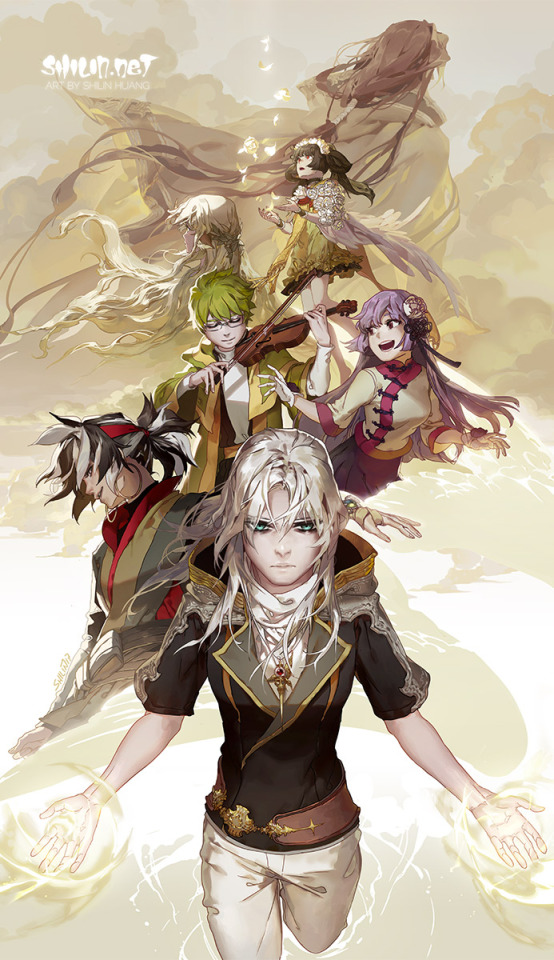
Shilin’s newest book, Amongst Us, based on the webcomic of the same name, is an alternate universe comic that reimagines Veloce and Blackbird as musicians and girlfriends in the modern world. You can support the physical release for Amongst Us book 1 on Kickstarter today.
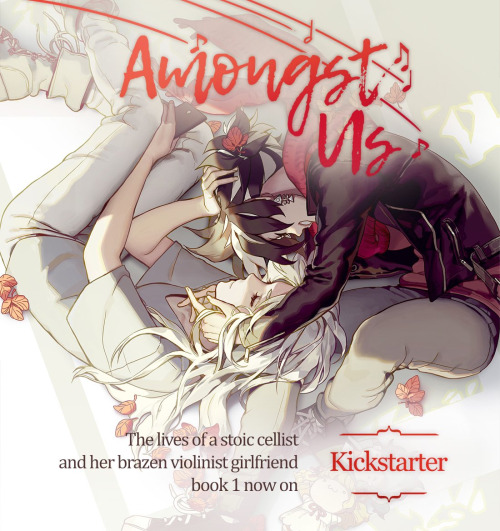
The first book of Amongst Us is coming soon. How do you feel about the release?
Eager and relieved!! I had worked for so long to make the web format viable for print format, as well doing all the extra drawings that were necessary--like covers--that I had to keep under wraps, it felt great to know that that part is finally done and I can release my child into the wild. I was very worried too before the launch of the Kickstarter, because though I am the one who made this story, I am not quite a slice-of-life type of person myself, and it was hard for me to see value in this mundane, not-plot-driven kind of story as a printed book. But I was very lucky to have that worry dispelled!
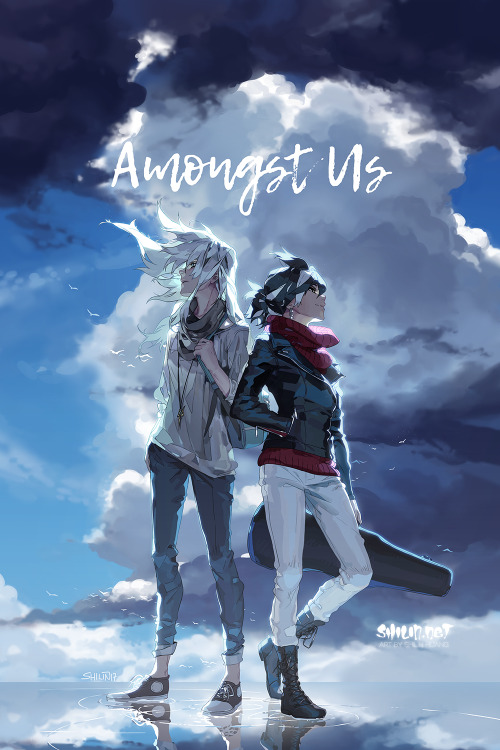
What drew you towards creating comics and artwork? Was it a dream of yours?
I’ve been drawing since before elementary school because I enjoyed it, and somewhere along the way, I wanted to create my own characters, and then I wanted stories for them. It was always just me doing what I felt like doing, more so than something that I aspired towards achieving consciously. If I had to analyze the allure myself, maybe it was because people and the world are so interesting, I’ve always loved thinking about their nature and circumstances, and art/storytelling was the best way for me to explore and share those thoughts.
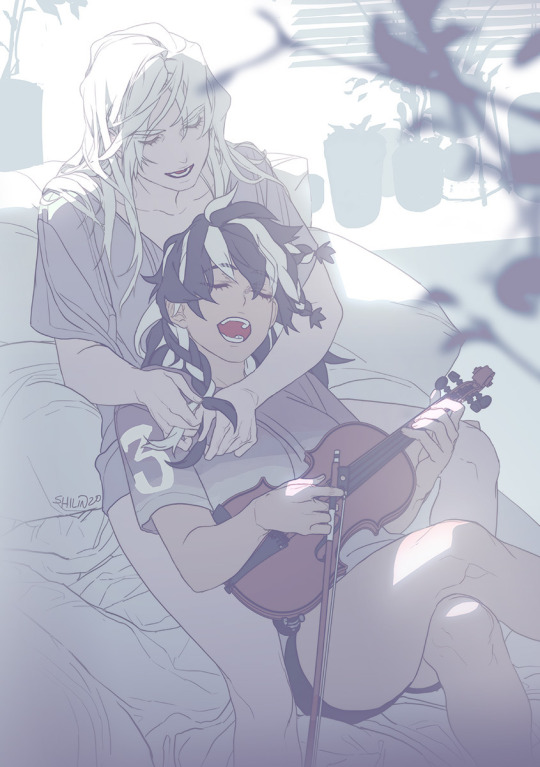
Could you briefly walk us through your creative process for making a page of Carciphona or an episode of Amongst Us?
Carciphona is a long, plot-driven story, and so the scale of preparation required before the page eclipses the actual drawing of the page itself. [A] small moment has some larger impact in the plot, character development, and accuracy of world-building. So I usually spend about half a year or more writing out an entire volume, read it over many times over the course of the years, before I do the same thing with sketching the entire volume on the computer, rearranging pages and panels and entire scenes for best delivery, before I finally commit to drawing out each page in detail on the computer.
Where Carciphona is like an elaborate set course where I chop up and measure ingredients and time their cooking with a careful game plan so everything can be served as they should, Amongst Us is more like an omelette that I’m making to taste. There is still planning and writing ahead of time, but each episode is much more self-contained, and I do more of the planning of the episode within the episode itself, adding and taking away details as I see fit before I feel like it reads naturally enough for me to fine line, colour, and paint.
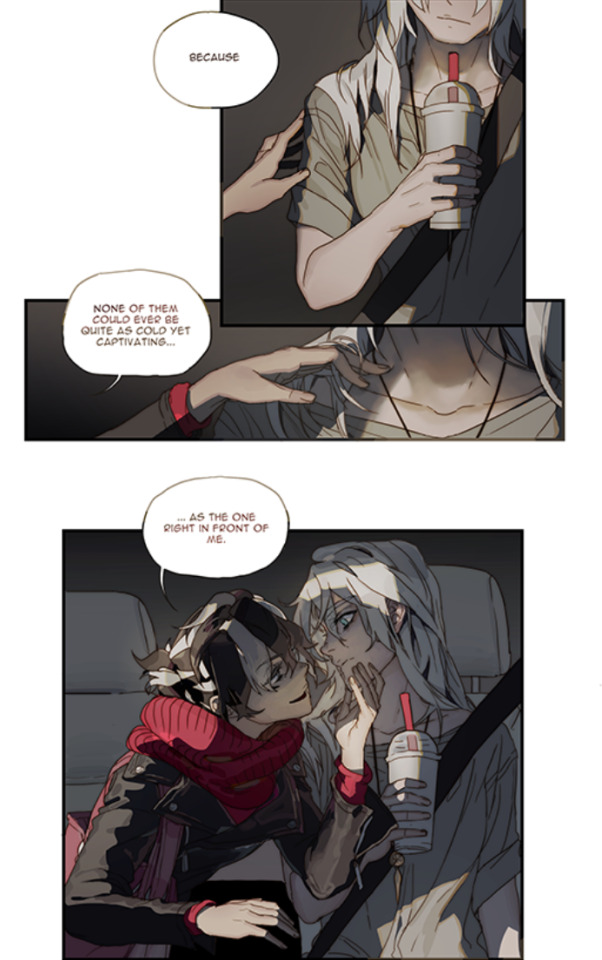
You talk about being a self-taught artist, how did you learn to create artwork? What are some of your favorite educational resources?
While I did come across many tutorials, they were mostly short ones here and there made by my peers, so I don’t have any favourites in my mind that I can share ): . I learned by just looking at the art of my peers at the time and drawing a lot myself, thinking about what I could learn from each time I see something great, and what I could try next time to make the next drawing look better to me. When I had just started drawing digitally, the internet was quite new, drawing tablets expensive and uncommon, with no social media to share art or find resources. Over time, I did try to learn more properly by doing studies and seeking out professional tutorials, but I found that I hated it and decided that I’d rather learn and make mistakes at my own pace and be happy than to commit to effective and efficient learning and make myself dislike drawing.
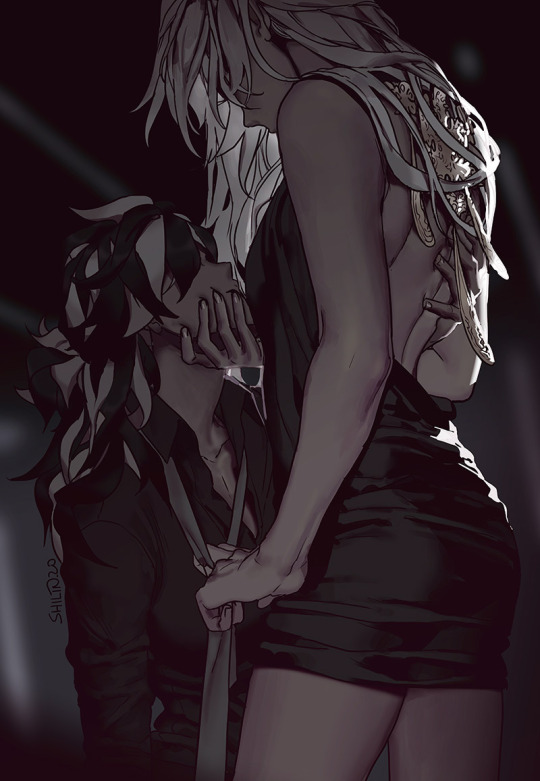
Amongst Us is, of course, an Alternate Universe comic featuring characters from Carciphona. What inspired you to put your characters into a GL slice of life work?
Back in 2006, when I started drawing Carciphona, I had no plans of this frenemies dynamic for the two main characters, Blackbird and Veloce, and when the thought had occurred to me as I continue to tweak the story, canon GL relationships were still rare and rarely accepted. I was even told on many occasions by readers that they hope the two do not end up with some couples dynamic, or they will no longer be interested in the story. Ultimately, Carciphona was a fantasy story about an entire world, and I wasn’t going to risk the story’s reception over a small detail like whether or not Blackbird and Veloce sleep together, so I just played with the ideas of their relationship on the side, in paintings of many different AUs. Eventually, all that did was make me become so attached to the idea that I decided to say, screw it, I need someplace where they could be together, and I’m drawing an AU for real.

Where do you draw inspiration from for your work? Both Amongst Us and Carciphona.
I love a lot of things, feelings, aesthetics, and I eat up all of that and take it back out in the form of my stories. The inspiration is everywhere, from beautiful imagery I witness in pictures and in real life, to [the] lives of people that I hear about or experience firsthand, to the ethics and structures of professions from mechanics to medicine… In feelings, knowledge, and perspective, there’s an infinite amount of things that makes me think, and that thinking is what creates AU and Carciphona, whether or not that line of inspiration can be clearly drawn back to the root of the thought.
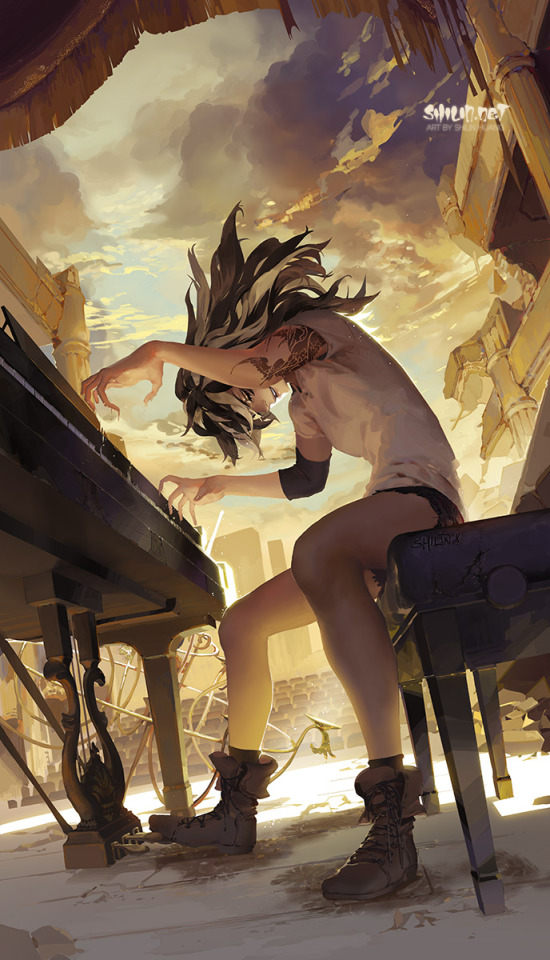
What are some of your biggest challenges or fears creating Amongst Us? Was there any realization or advice that helped you overcome those difficulties?
My biggest fear is always in relatability because it’s a difference between me and the reader that I do not and cannot have a solution for because it involves another person. In such a relatable genre as slice of life/comedy/romance, where the readers have more experience and therefore more varied but stronger expectations of a version of life that is relatable to them, I know that even if somehow I become a master writer, I still would not be able [to] say whether I could story that others would get or would be interested in, especially because I am aware I am an oddball when it comes to how I think, how I live, and what I value. What helped me the most was simply seeing that there were readers who did enjoy the stories for what it was, and reminding myself that I’m telling the stories to find those who might enjoy it, not to avoid those who might not. It’s a different perspective, rather than a solution, so the worry constantly resurfaces, but I hope it becomes easier over time as I am proven wrong more often!
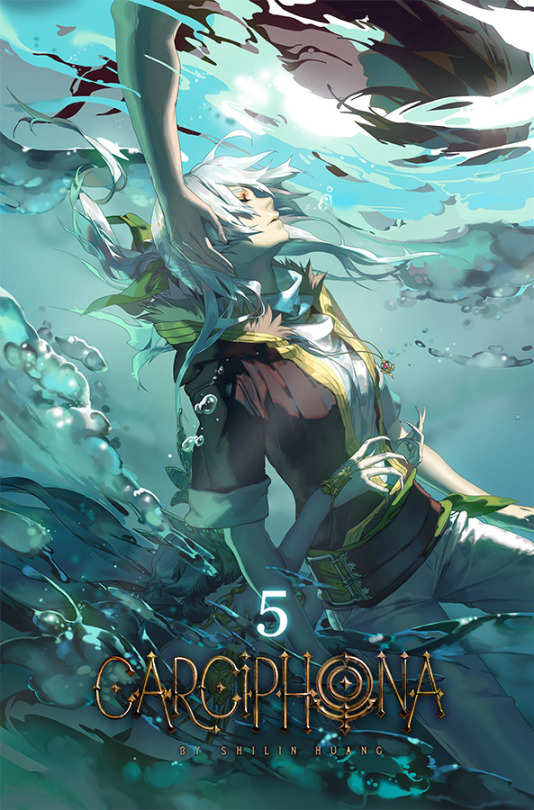
Amongst Us readers have gotten to see Veloce and Blackbird as an established couple, and now we are witnessing flashbacks to how they first met. Where do you hope to take the series in the future?
I intend to tell both of these timelines concurrently, so as the couple timeline ended at episode 20, I intend to end the flashback at around episode 40, and then switch again at episode 60, and so on. While this kills the momentum for each arc, I made AU so that I can have the cake and eat it too--I want both their back story and a happy ending at the same time without having to wait 10-20 years for it, like I do with Carciphona’s plot haha!
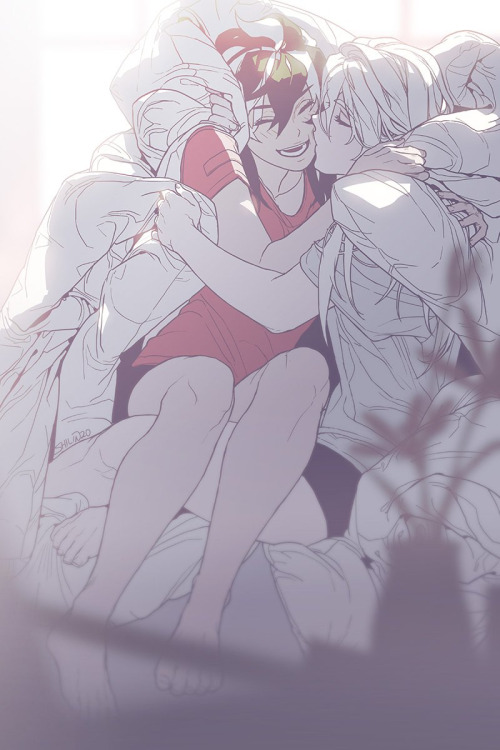
What is one dream or aspiration you would like to accomplish? Even if it is unrealistic.
My only dream right now is just to finish both Carciphona and AU before my time’s up! Funny how unrealistic is specified, it made me realize that I rarely consider unrealistic dreams/aspirations as worth thinking about as they are unlikely to happen when there are so many other things I want to do that are actually possible. Most of my unrealistic dreams actually revolve around music, a profession I had left behind with an aching heart. I dream to play a concerto with an orchestra someday, or even learn to conduct, but for now, drawing my dreams out feels enjoyable and fulfilling enough a compromise!
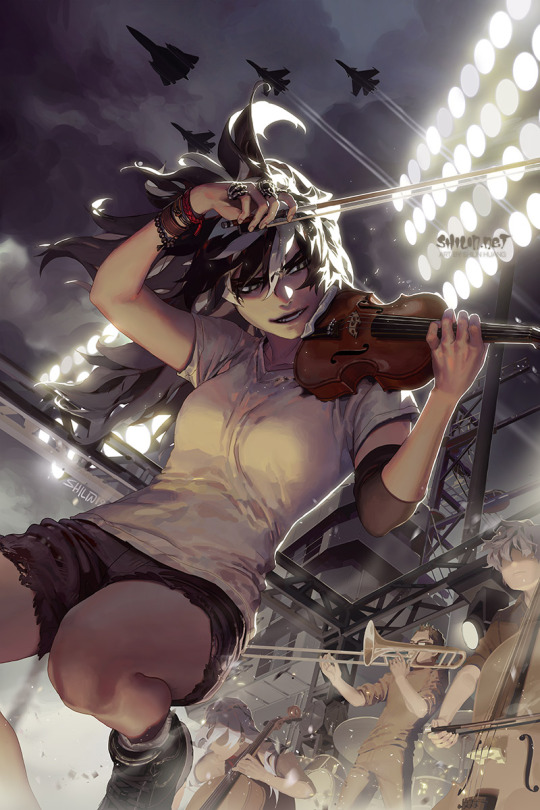
What advice do you have for people wanting to create artwork and comics?
The true challenge these days I feel like is rarely in the work itself; there are so many readily available free resources that anyone who is capable of working hard and thinking critically will sooner or later be able to master skills they acquire to some degree. What is truly challenging is finding, and then accepting, what paths work for you. Someone might find great joy in working in a studio with a group on something big, while someone else might only enjoy drawing what they feel. Both, in this current climate, will be compelled to adhere to the standards of drawing what others want to see in order to gain recognition and financial stability, one will thrive, one will not.
I think the most important thing to keep in mind is understanding what you want out of drawing/creating, and why. Understanding yourself is often not as straight-forward as it may seem, everyone has different circumstances that subtly motivates them to sometimes misdirect energy and misinterpret what it is they truly want. Some people need to be understood, some people want an excuse to execute, and some people want fame, money, recognition, validation. Whatever it is, and all valid, understanding and accepting your own motivations to create can tremendously help you find the path forward that is suitable for you, not anyone else, even if it might mean following an impractical path that no one else recommends.
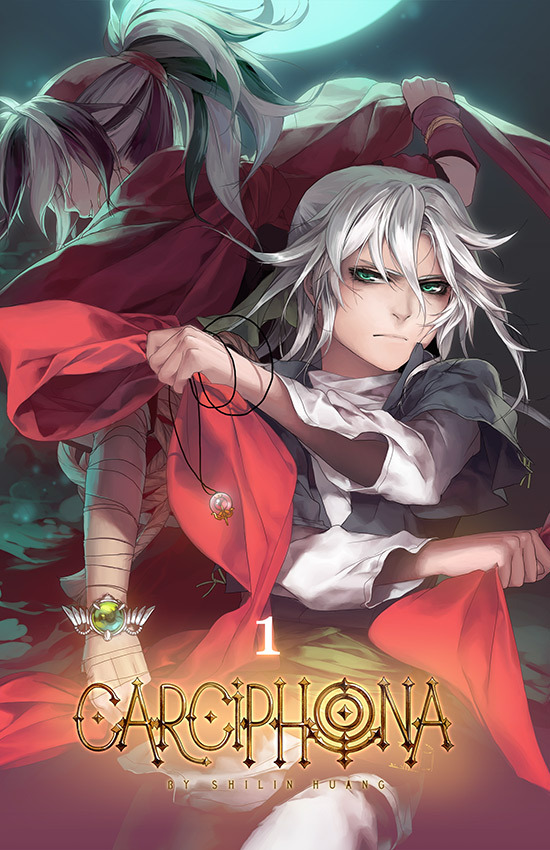
Finally, after the release of the first Amongst Us book, what is next for you? Anything special your fans can look forward to?
My game plan through the decades has always been to just keep going. I did choose long-form projects such as the comics that I draw, and the best thing I can do is to just keep it up and reach those exciting points of the story that I’ve always worked towards, no matter how uneventful that may make my work routine sound. However, I do have a little side thing with a(nother) recurring theme that I’ve been doing here and there for fun whenever I had time, people who keep up with my social media art posts may have noticed. If I ever accumulate enough material, maybe there will be some bonus snacks for my readers on the horizon!

Read Carciphona and Amongst Us online now and be sure to support the physical release on Amongst Us book 1 on Kickstarter today. Also, be sure to follow Shilin on Twitter @Okolnir.
#yuri#news#essay#lgbt#lgbtq#lgbtq+#queer#gay#shilin#girls love#gl#wlw#essays#interview#art#artist#comics#indie#carciphona#amongst us
1K notes
·
View notes
Text
X-Men Abridged: 1975
The X-Men, those super dramatic mutants that have sworn to protect a world that hates and fears them, are a cultural juggernaut with a long, tangled history. Want to unravel this tapestry? Then read the Abridged X-Men!
(X-Men 94 - 96) - by Chris Claremont, Len Wein and Dave Cockrum
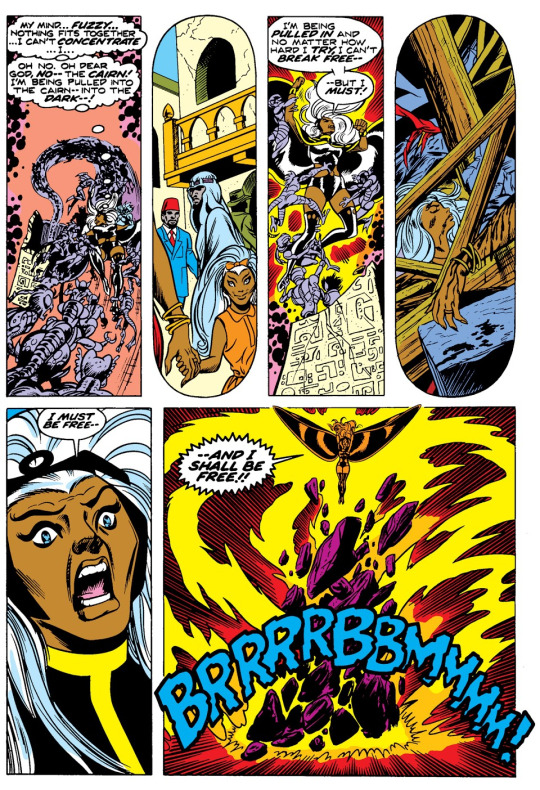
You think I won’t automatically be able to include a powerful Storm-moment in every instalment? Watch me. Claremont is a much bigger Storm-fan than I am. (X-Men 96)
So, originally, the plan for the All-New X-Men would’ve been very different: the series would have remained Giant-Sized and it would’ve come out four times per year. This format would have allowed enough room to split focus between thirteen team-members. However, when the Krakoa-issue turned out to be crazily uncannily astonishingly popular, the series became a bi-monthly series. This necessitated some changes, especially in the roster.
Also, there’s this new writer? Chris Claremont? idk man, he seems a little dramatic
The first thing this new kid on the block does, is clean house: he jettisons almost all of the original X-Men, except for Cyclops. In a tear-filled goodbye, we finally get our first on-panel kiss between Jean and Scott. Fucking finally, only took you twelve years, but also: aw.
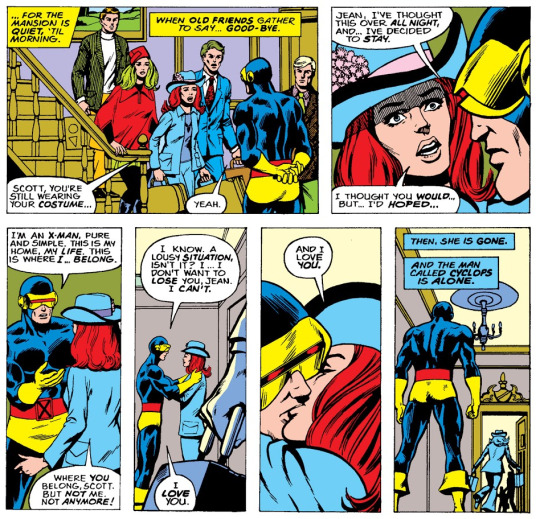
C’mon Scott, you can try long distance! Consider the benefits, like not having to look at your girlfriend dressing like a Hart-of-Dixie villain. (And don’t think you’re off the hook, Lorna. You look like a Christmas ornament) (X-Men 94)
Sunfire, surprising no-one, also leaves. (For real this time.) I’ve always wondered what the original plan for him would have been, but considering there are two other grumpy and angry rebels on the team (Thunderbird and Wolverine), I understand why Shiro would be a little redundant. It is a shame that it’s a POC that gets discarded, especially considering what happens later.
No time for absent souls, let’s get into the plot! Thunderbird desperately wants to prove himself, while Scott wants him to show some restraint. They butt heads and T-bird gets hurt during training. Despite his injury, he insisting he joins the team on their next mission! Because it’s the Avenging Ex-X-Man Beast who calls for aid.
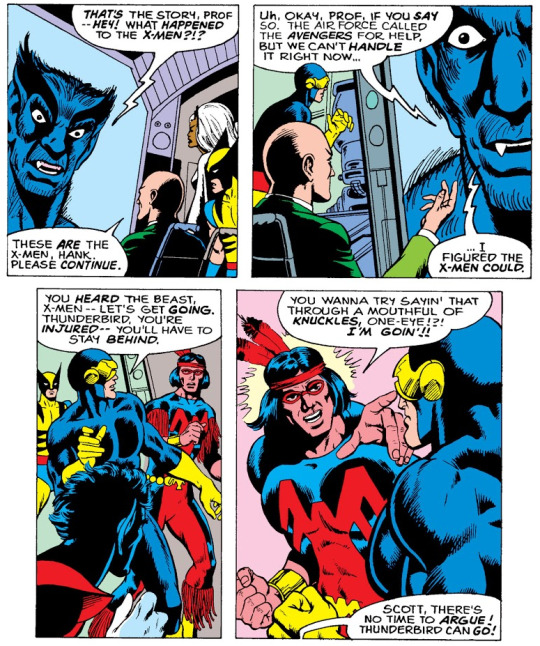
I love that Beast brushes aside this almost entirely new team of X-Men just as easily as my aunt brushed aside the new boyfriend I brought home for Christmas. (X-Men 94)
As an aside, I’m assuming y’all know what happened to the Beast: in the Avengers, he experimented on himself and turned himself furry and blue. One of his most iconic moments! (And it didn’t even happen in an X-Men comic.)
Count Nefaria has once again allied himself with a team of silly super-villains and invaded the NORAD (North-American Air Command) in order to ransom the entire world with nuclear weapons. When the X-Men approach, Count Nefaria shoots them from the sky and we get one of the hallmarks of Claremont’s writing: the sometimes unnecessarily DRAMATIC CLIFFHANGER! Because the issue ends as the X-Men plummet to their FOR SURE INEVITABLE deaths…
Except, you know, Colossus doesn’t really do falling damage and Storm and Banshee can fly.
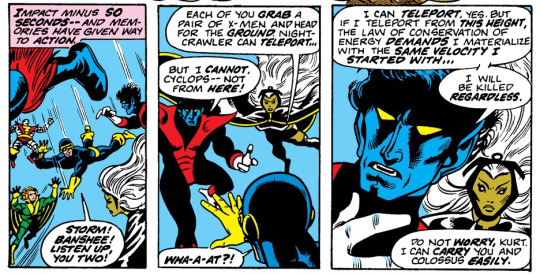
Look, realistically, all of them would’ve hit the ground somewhere around Kurt’s second sentence. (X-Men 95)
When everyone is safely down, Nightcrawler teleports inside the base and lets the rest of the X-Men in. Colossus gets to shine by protecting the rest of them from bullets, while Storm washes the hypnotized soldiers away with a quick flood. They fight the Ani-Men but the two X-Men who haven’t had the time to shine… are promptly knocked out.
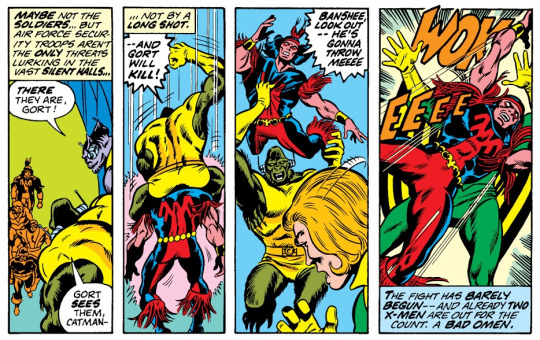
“Gort wanted to take out that mutant, so Gort just threw the first thing Gort could find.”
“Which was?”
“Another mutant.” (X-Men 95)
Banshee and Thunderbird perform pretty poorly, while the other X-Men try and stop the Doomsday Clock that Nefaria started.
It’s a little confusing how the clock is stopped - somehow, all the fighting and ruckus in the base stopped the clock from going to zero, preventing the launching of the nukes? Seems like a design flaw, US government! Anyway, the Doomsday Clock is not the focus of this story, not really: this is a story about John Proudstar and his desperate need to prove himself. In order to stop Count Nefaria from escaping, the heretofore useless John jumps on his plane and begins tearing at it.
It’s a foolish plan. The plane ascends and begins to smoke while John keeps pulling off bits and pieces. Banshee gives chase, screaming at Thunderbird to get the fuck off that thing (laddie). But…
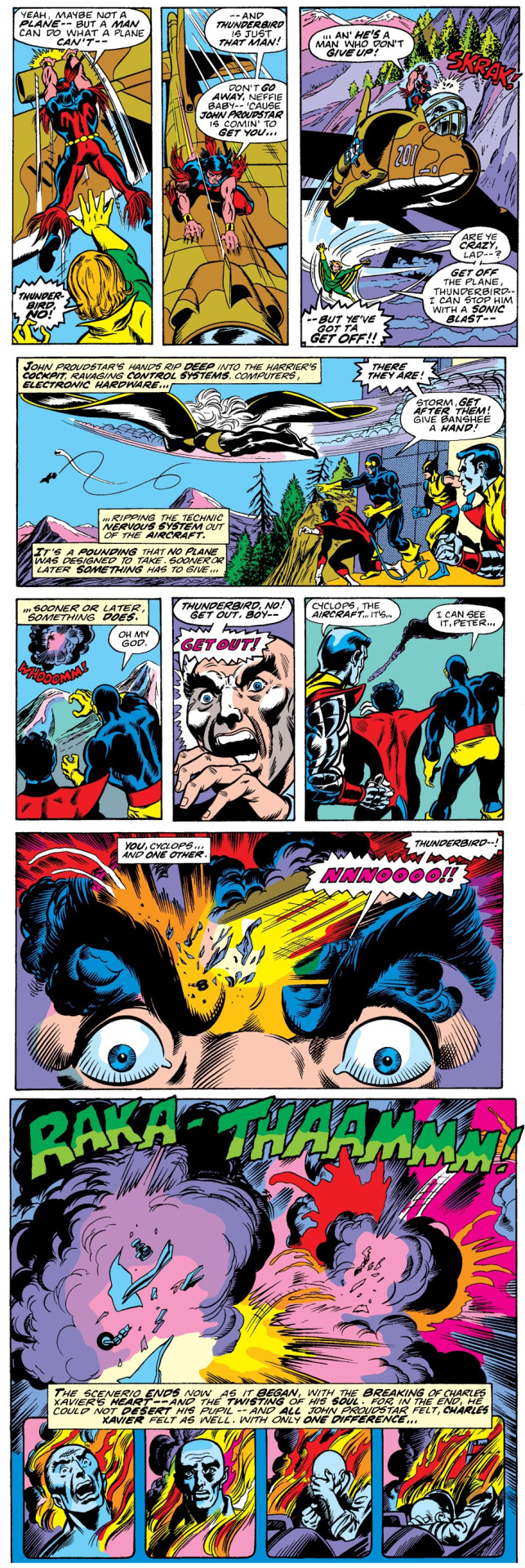
Just like John, Charles doesn’t recognize a hopeless situation when he’s right in the middle of it and is just as unwilling to let go. (X-Men 95)
Now, John Proudstar is not entirely unproblematic as a character. With Storm, they get things mostly right, especially considering what decade this was and how white Marvel was. Thunderbird, on the other hand, veers dangerously close to becoming a nasty indigenous stereotype, especially considering his outfit and attitude. Claremont will redeem himself in the future by writing much better characters that are Cheyenne and Apache - Forge, Mirage, Warpath - but as it stands now? John is barely a flat character and it’s a shame that, after writing out Sunfire, the first character to die is also a POC.
And yet, despite the fact that this storyline is Claremont’s first X-Men attempt, and despite the fact that it’s uneven, over-dramatic and has a silly villain, it still takes balls to kill a member of a barely established team. (Especially considering the time and age.) And, while the plotting is a bit thin, the moment where Xavier feels Thunderbird die is pretty effective.
The next story is a lot more typically Claremont, and a lot better. Back in Westchester, Emo!Scott, in all his failure-as-a-leader, someone-died-on-my-watch anguish, damages a cairn when he lets loose. Randomly, this is a capstone to some demonic dimension and Scotty accidentally unleashes a demon.
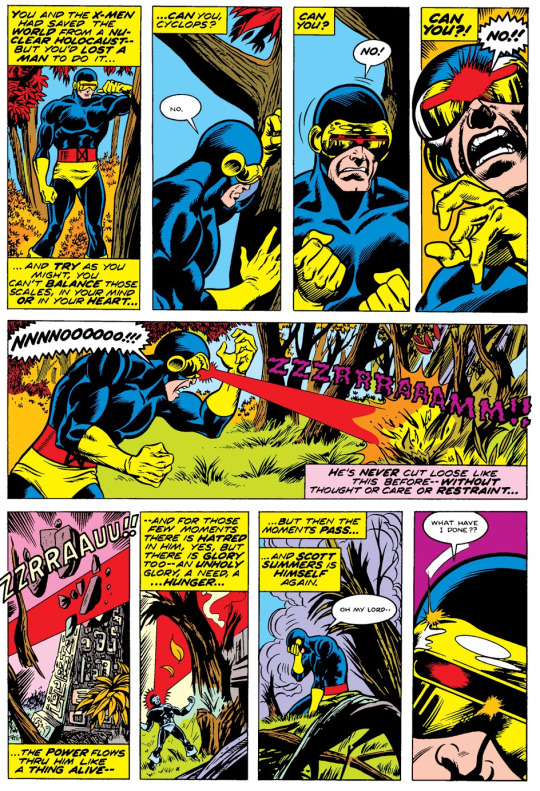
Can´t you imagine this scene being a lot funnier if the yellow panels are just Claremont shouting at Cyclops? Can’t you?! Can’t you?! (X-Men 96)
Meanwhile, Stephen Lang, an anti-mutant army-man, wants to kick off Project Armageddon, which builds on themes established by the Trasks. Michael Rossi, a colonel who gets imported from the Ms. Marvel-lines Claremont was working on before, wants to hear none of this, so Stephen has a little accident arranged.
Back in the mansion, a surprise new addition to the cast arrives!

Maybe housekeeper was one of the identities Moira X had tried out in a previous life, before quickly realizing that being a scientist would better suit her purposes. (X-Men 96)
Her welcome is rudely interrupted by the arrival of the demon!
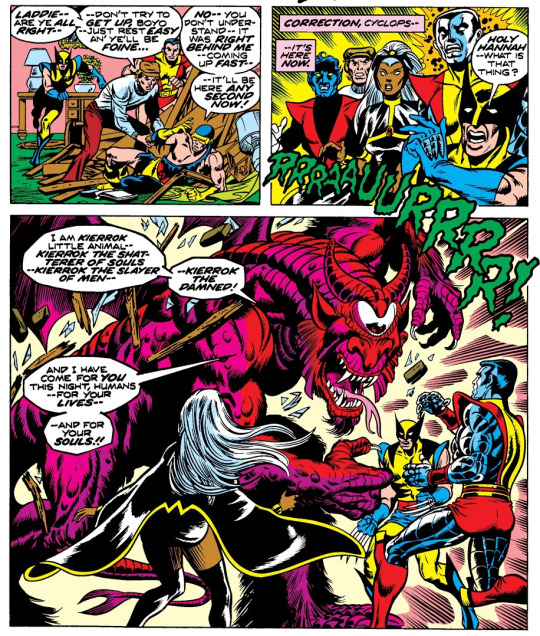
More like Unholy Hannah, amirite? (X-Men 96)
Both Wolverine and Storm get their chance to shine, before Storm manages to restore the cairn and lock out the demon invasion. And this is where Claremont actually shines. He’s great at building concurrently running storylines, teasing future plots instead of making it a mishmash of X-Men being attacked by random villains. Furthermore, he actually uses action scenes to further the plot or give depth to his characters. Deftly, he introduces Wolverine’s berserker side and teases at Storm’s claustrophobia. Check it out:
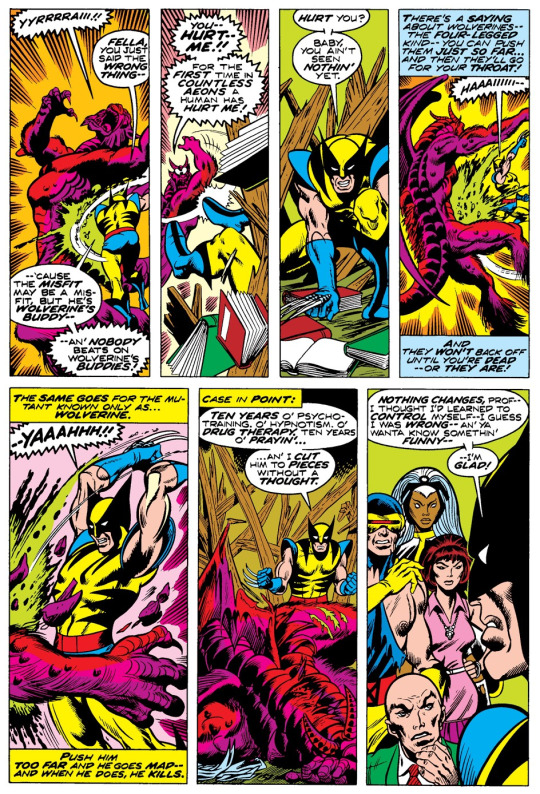
Hey, James, I think your barbarian just unlocked the berserker rage feat. (X-Men 96)
Sure, Claremont sometimes makes the X-Men little more than a superhero soap opera, but he does it so well. We’re truly in a new era now. I can’t wait.
For Whom the Death Tolls: Thunderbird. One of the few X-Men for whom death is actually a sort of permanent state. Has he been spotted on Krakoa yet?
What could have been: Imagine X-Men if Sunfire or Thunderbird had taken the place of ‘angry loner’ on the team, instead of Wolverine. Also, I wonder why Claremont never bothered to connect the demons under the cairn to Limbo - the N’Garai are an entirely separate dimension. Maybe Westchester is just a hotbed of demonic activity.
What to read: None of it is truly pivotal, but X-Men 94 and 95 are hallmarks for the death of Thunderbird. X-Men 96 should be on your reading list if you’re a fan of Wolverine and Storm.
#x-men#x-men abridged#abridged x-men#charles xavier#professor x#scott summers#cyclops#ororo munroe#storm#wolverine#james logan howlett#logan#nightcrawler#kurt wagner#colossus#piotr rasputin#thunderbird#john proudstar#chris claremont#len wein#dave cockrum#jean grey#marvel girl#iceman#bobby drake#angel#warren worthington#havok#alex summers#polaris
34 notes
·
View notes
Text
Twilight/ Come In With The Rain Theory
Come In With The Rain was released on Fearless Platinum Edition on October 26th, 2009. In the Lover notebooks, some of the lyrics could be traced back to October 2006.

Concurrently, the book Twilight was released in October 2005. The 3 sequel books were released in 2006, 2007, and 2008. Taylor was in the target group to the Twilight series. Chris Weitz, the director of New Moon (2009), also said in a recent interview that his agent told him “Listen, Taylor Swift is a huge Twilight fan. She would love to be in this movie.” Taylor also went on to do a Twilight sketch on SNL and dated lead actor Taylor Lautner.
On early albums, Taylor said her inspiration for love songs came from stories she read or movie romances she had seen. Due to Taylor's obsession with Twilight and her lack of romantic experience up to 2006, it is very likely that she was inspired off of the romance between Edward and Bella in Twilight. One moment in the story includes Bella leaving her window open and Edward coming in at night in the very rainy town of Forks. The chorus of Come In With The Rain goes:

Twilight's sequel, New Moon, is about Edward leaving Bella and Bella waiting around and hoping he would come back to her. Come In With The Rain is about the singer being left by a guy and hoping he would come back to her. Both Twilight and Come In With The Rain use rain and clouds as the main imagery to describe the environment.
I believe that Come In With The Rain was originally inspired by the books of Twilight and New Moon. Taylor tried to become part of the New Moon movie to have her song part of the soundtrack. When this was denied, she released the song as part of Fearless Platinum edition instead, which came out the same year.
140 notes
·
View notes
Text
12 Months’ Pandemic Chronicled | #51 | March 2021
Happy Palm Sunday yesterday, and Happy Passover from the night before! Right under two weeks ago, March 16, 2O2I, marked the one-year anniversary to the close of my first Peace Corps Mongolia service. While I’ve continued to serve virtually, I’ve done so informally as a Returned Peace Corps Volunteer. Having lived these past 12 months back in the States, today’s tales chronicle that year.
Also commemorating the one-year anniversary, I’ve uploaded dozens of photos from my first nine months serving Mongolia. You can find those on my Instagram and Facebook, from February and March. I begin today’s stories with those. From there, I chronicle my journey across the year.
Evacuating Mongolia (February 2O2O)
February’s final week, on Ash Wednesday 2O2O, I was in Mongolia celebrating the third day of Tsagaan Sar, its Lunar New Year. Returning to my apartment from my last supper, I read an email from Peace Corps Mongolia that we were evacuating. I pulled an all-nighter packing my apartment. Shortly after sunrise, I visited a Peace Corps neighbor’s apartment to pack theirs. Then in my final two days, I said hasty goodbyes to community members, exchanging parting gifts.
Sunday morning, which began Peace Corps Week and March 2O2O, I and fellow Volunteers loaded into Peace Corps vehicles and rode in our caravan till evening. Then the snowstorm caused us to need to stay overnight in a hotel coincidentally located in a city that my cohort would frequent during our summer 2OI9 for training. My evacuation group reached Mongolia’s capital Monday afternoon, with briefings from staff throughout Tuesday. Mongolia had already begun to enforce mask-wearing and physical-distancing, so we couldn’t do much with our final hours in Mongolia. Indeed, since mid-January, many public places had already closed due to quarantine.
Wednesday night, the week after my peers and I had received notice of our evacuation and now mere hours before my group would depart the country, we awaited the arrival of fellow Peace Corps peers to the capital. For, Peace Corps staff staggered our arrivals into and departures from the capital to account for both the time drivers would need to assemble us from across the nation and the limited flight options still going out of the country. Those of us who remained awake through our final night enjoyed getting to see and embrace peers for our final moments together.
Over the course of Thursday, March 5, my group flew first from Ulaanbaatar, Mongolia, through Moscow, Russia, to Berlin, Germany. Many of our itineraries diverged. From Germany, I and a few flew to Amsterdam, the Netherlands. From the Netherlands, I and a couple others flew to New York, New York. I slept four and a half hours’ in a hotel. Then I flew alone Friday from New York to Las Vegas, Nevada. I returned to my home of junior high and high school in North Las Vegas.
American Twilight Zone (March 2O2O)
My first few weeks in the States felt weird, not just because of reverse culture shock. Back in Mongolia, fellow Peace Corps Volunteers, particularly Health Volunteers, had followed American media and read that our presidential administration had been downplaying the COVID-19 pandemic. Problematically, too, when leaders acknowledged it, some labeled it the “China virus” and accused Asians of spreading it. These set the tone.
When I arrived in New York, I felt perturbed by the lack of mask-wearing and physical distancing. The morning when I’d fly out, I felt annoyed when the worker who checked me into my flight joked that I might have the virus since I’d flown in from Mongolia. Mongolia had no COVID cases—and wouldn’t have its first community transmission till November 11, 2O2O. Friends, too, when I said that I’d come back, distrusted that I couldn’t have the virus. So, although Peace Corps peers and I had already been quarantining nearly a month and a half before returning to the States—and very much craved to reconnect with folks—we found ourselves again isolated.
Then Vegas felt weird. Nevada had reported its first COVID case the day before I returned, yet Mongolia hadn’t any. Yet Mongolia had shut down, and Nevada hadn’t. Society moved as though little was happening. My brothers still had school and were gone most of most days. Dad worked weekdays out-of-town. Thus, while I lived again in the States, even inside my family’s home, I was the only one around. I felt lonelier than how’d I’d felt before leaving my life abroad.
The Filipina family of my father’s fiancée was perhaps the most understanding of my circumstances. The oldest daughter was celebrating her birthday that first Sunday, March 8, since my return to the States. So, I got to join them in enjoying the occasion. As I’d come to learn, Mongolia and the Philippines had more cultural similarities than I’d expected. I’d also feel dismayed to learn that people weren’t treating the youngest daughter kindly in her food service role, for some customers believed that her being Asian meant that she had the Coronavirus.
Resettling Into Lent (March 2O2O)
Most every morning, my first few days and weeks, tracks from Disney's “Frozen II” became my anthems. I’d seen the film that Friday, March 6, when I’d flown alone back to Vegas. I’d connected especially with “Show Yourself,” “Some Things Never Change” and “The Next Right Thing.” I started to learn the lyrics not only in English but also in Mandarin Chinese and Spanish.
My local church was still open. Meanwhile, in Mongolia, our church had been closed for nearly months. So, I attended services daily. I overheard old parishioners wondering what all this pandemic talk was about. I visited Reconciliation and a Stations of the Cross service. I applied to sing in the choir with which my late mom sang.
My second week in the States, church and schools closed. Meanwhile, Peace Corps announced its global evacuation. My peers and I weren’t to expect to return to Mongolia this summer and instead were to expect that fall would be the soonest. My youngest brother’s hs senior spring ended abruptly, so he stuck around at the house. Our oldest brother left to quarantine with his girlfriend and her sisters.
I cleaned much in and around the house. My greatest achievement early in the pandemic was to lead a garage clean-up with all siblings when my sisters visited. The task enabled us to at last park a vehicle in it once more. My siblings and I donated, too, decades of belongings.
Among the unearthing, I dove deep into family history. I wrote up my understanding of my father's and my late mother's ancestries, which were also mine. Months later, I'd join WikiTree, talk to distant relatives and migrate large swathes of history onto the platform.
Easter in Action (April–May 2O2O)
Gloom seemed to enshroud the world by Easter. I saw from the telly the Vatican's Lenten services, witnessing Pope Francis’ words from his city to the world and for Holy Week. His Good Friday Way of the Cross felt especially moving, for prisoners had written beautiful reflections that made me realize how little of a prison our quarantine was.
My younger sister in LA had also returned to visit Vegas. I resumed daily exercise routines, including trying to concurrently complete handheld video games and walk miles on the treadmill. This began my May push to make the most of my days back in America. I kicked up a daily Duolingo habit, rising through leagues, and talked regularly with Mongols during early mornings. Such helped my sanity, especially when state offices gave me a hard time trying to get the unemployment assistance to which lawmakers entitled evacuated Returned Peace Corps Volunteers.
Around Memorial Day, an uncle and aunt visited from Kansas to celebrate my youngest brother’s high school graduation online. The relatives also took my siblings, a family friend and me on my first national parks trip in years. We saw Saguaro, Great Basin and Capitol Reef. During the trip I’d grown my Goodreads library and soon enough uncovered the Libby app. The journey led me too to begin a pensive look back on my life.
Summer in Reno (June–July 2O2O)
Dad remarried on June 6, 2020. Shortly thereafter, I relocated to Reno to help Pa and Stepma (“Tita”) handle copious amounts of yard work. With more time to reflect, I took up the request of a homebound friend to pray rosaries daily over the phone with him.
Another friend of mine was going through a dark patch too but had a love of films. So each morning I’d rise early to see one of his recommendations then discuss it while working the yard if I wasn’t praying a rosary. I fondly recall the conversations while trimming plants, as I wander the Reno backyard even now.
Near the same time, the friend and another encouraged me to tell my stories. So I began to write a memoir, on which he’d give feedback. The other friend had me appear on his podcast. Both experiences made the summer feel very whole. In memory of my first summer in Mongolia 2OI9, I also wrote a more detailed series on those experiences. [Arrival (June 2OI9), Meeting Host Family (July 2OI9), Summer’s End (August 2OI9)]
I celebrated my 23rd birthday in Vegas with an overnight vigil, praying 23 rosaries alone and with Catholic friends from around the globe. I felt such joy to reconnect meaningfully with so many across languages and cultures. Languages became a growing theme for me. I’d also begun again playing Pokémon GO after having not played since 2OI6.
That summer, I finished seeing “Star Wars: The Clone Wars” (Season 7) as well as relevant bits from “Star Wars: Rebels.” I kept up with the Japanese episodes of “Pokémon Journeys: The Series.” Those, I’ve watched with English subtitles to know what’s happening. I’d also begun to read chapters of the Bible daily, at that time checking in weekly with an ol' friend. I started with Acts then Proverbs, Ephesians then Psalms. Meanwhile came Hebrews and John. Then were Ruth and Matthew. Now I read 1 Kings and Mark. I’d grown to appreciate both the Hebrew and Christian Bibles with renewed interest.
Autumn Languages (August–September 2O2O)
Much of that fall, I was back in Reno. Yet, my younger brother had also come to Reno for his undergraduate fall semester. The guest room where I’d stayed quickly became his room, which left me a tad displaced. Still, I stuck through. Mornings, I rose early to read through a Latin textbook before daily conversations with a close friend who’d majored in classics as an undergrad.
Meanwhile, I’d stepped up to arrange meetings with Congressional lawmakers on behalf of the National Peace Corps Association. I’d also taken on roles within my alma mater Honors College and within the Social Justice Task Force for the American Psychological Association’s Society for the Psychology of Religion and Spirituality. I kept people organized and took notes during meetings. Meanwhile, my siblings and I had been starting a scholarship foundation, so I’d taken point on negotiating a partnership with the Vegas-based Public Education Foundation.
As a nice break, I joined friends I’d met in high school on their near-monthly trips to national and state parks. These sights included Lassen Volcanic, Burney Falls and Tahoe’s Emerald Bay. Realizing that I wouldn’t return to Mongolia that fall, I booked a Department of Motor Vehicles appointment to renew my learner’s permit—The earliest appointment would be in December.
In entertainment news, I’d finished seeing “Queer Eye: We’re in Japan,” “Love on the Spectrum” and “Midnight Gospel.” I’d also started playing “Pokémon Masters EX” when I’d heard that it included characters from multiple generations. I enjoyed how the stories felt new yet nostalgic.
National Park Winter (October, November, December 2O2O)
October was a great month for my spiritual life. I got to attend my youngest sister’s Confirmation. I enjoyed my first retreat in years. I also got to tape videos for my alma mater.
Then I returned to Vegas some weeks to complete more yard work. I’d also relocated belongings in different rooms and was able to have my own bedroom back in Vegas. This gave me a decent space in which to work. From November, I’ve also been hosting weekly video calls to help Mongols from my community abroad continue to practice English.
I’d also listened to Riordan audiobooks, “Blood of Olympus” and “Hidden Oracle,” and various authors’ financial literacy materials. By December, “Kafka on the Shore” was a real highlight. In Reno, I saw too “The Mandalorian” (Seasons 1–2), emphatically recommended by a friend with whom I’d hiked at Red Rock Canyon. My other friends and I reunited to try again at Crater Lake and succeeded.
My siblings and I partnered with the Vegas-based Public Education Foundation to launch our family LinYL Foundation to honor our late mother with scholarships for students. Though my formal role’s within outreach, I’ve done a fair bit of organizational leadership given my undergrad experiences. I’ve also been helping another non-profit start-up. Through it, I’ve gotten to meet alumni of overseas programs.
My family celebrated Thanksgiving and Christmas in Vegas with our stepsisters. I’d also celebrated American Independence Day with them. Christmas felt peculiar, as I’d returned from Mongolia to Vegas the Christmas before, too!
Then my national parks friends and I hit a new record, seeing Walnut Canyon, Petrified Forest, Meteor Crater, Sedona’s Devil’s Bridge and the Grand Canyon. Having successfully renewed my learner’s permit, I scheduled my driving test for the earliest date—February. I returned to Reno and at New Year’s reunited with friends for whom I’d participated in their wedding the year before.
Road to Rejuvenation (January–February 2O2I)
Following the U.S. elections came the presidential inauguration. I felt more at peace with the state of the nation after that. Though U.S. politics have absorbed media significantly throughout the pandemic, I felt relieved by the calls for unity and returns to political normalcy from Inauguration Day.
Meanwhile, I sought to kick off 2O2I strong, with renewed optimism and control. I practiced driving almost daily. I’d seen “Daredevil” (Season 3) too and progressed in the Blue Lions story of my younger sister’s “Fire Emblem: Three Houses” copy. At February’s start, after years of challenges, I secured my driver’s license.
Mid-February, my national parks friends and I saw Utah’s Mighty Five. Our trip spanned Canyonlands, Arches, Capitol Reef (different section), Escalante, Bryce Canyon and Zion. I got to help drive at the end from Vegas to Reno, a major milestone.
Thanks to Discord, I attended a virtual alumni reunion of my high school alma mater. I experienced our school's recreation in “Minecraft: Java Edition,” wandering into the classroom where I used to play “Minecraft” as a freshman. In “RuneScape,” after 12 years on-off, I’d achieved level 99 in all but the newest skill. I'd even gotten the characters I wanted in “Pokémon Masters EX” and nearly finished my Kanto Pokédex in “Pokémon GO.” (I've never before completed a Pokédex.)
I finished February recording music for my undergrad parish’s online edition to our annual performance for “Living Stations of the Cross.” I got to lector at and attend a friend’s baptism. I’d also soaked up my youngest sister’s boyfriend’s Disney+ again and saw “WandaVision” entirely. Its takes on grief and joy astounded.
Social Justice (March 2O2I)
These bring me to where and how I am today. I write from Reno, Nev., where snow had fallen and the weather grown warmer. Spring is here.
The announcement of increasing vaccines gave me lots of hope. Since I've lost so many people this past year to COVID-19 and other conditions I'm grateful that we may near the end. An email from and a check-in call with Peace Corps confirmed that summer would be the soonest I’m going back abroad. Still, I’ve kept in touch with my people in Mongolia.
My older brother and his girlfriend moved into the Vegas house, so I haven’t felt as obligated to be there. Thus, I’ve focused more time on the church in Reno.
A great fount of a spiritual joy for me has been getting to help lector for my college parish’s weekly Proclamations of the Word. I received particular acclaim for my reading from 2 Chronicles, for Lent’s Fourth Sunday, which delighted me. At the time I’d been reading 1 Kings, so I’d enjoyed recognizing parallels. In some ways the exercises are like a miniature college course. Beyond regular Sundays and Holy Week, I’d also lectored for such feast days as St. Joseph’s Day (March 19) and the Annunciation (March 25).
My siblings’ and my family foundation chose our first year of recipients. It’s been an exciting process, reading and witnessing our inspiring candidates. I hope that I'll get to meet these students someday, but ah, the pandemic.
I’ve gotten back into “Frozen II,” thanks to its authentic behind-the-scenes docuseries. I've also passed the one-year anniversary of my first seeing the film. Each morning I’ve sought to see something on Disney's platform—real' nice.
Our psychological division’s presidential task force for Social Justice released our statement about the Capitol riots, which received strong critics but stronger supporters. Then came the Atlanta situation.
In my U.S. Week 5I (Feb. 19–25), during a walk past the nearby elementary school, I’d had an unpleasant personal experience that led me to feel very grateful when the #StopAsianHate campaign began. I’ll likely share more later, but today’s blog story is about done.
Hope and Easter 2O2I (April 2O2I)
At the last Adoration activity before Easter, our parish offered Reconciliation, so I returned again. Absolution offers such sweet cleansing for my mind and soul. Now Holy Week begins. I'm still lectoring, too!
This summer, I hope to write more on my memoir. I’m still revising my research. I'm set to finish all five tiers of Duolingo Latin tomorrow. Then I'll get back to my textbook.
I still delight in chatting with ol’ friends. My national parks homies and I will hit Redwood next weekend. Then my parish has Spring Retreat. I look forward to getting vaccinated in coming months then hugging folks forevermore.
You can read more from me here at DanielLang.me :)
#Peace Corps#Mongolia#memoir#story#Catholic#God#memoryLang#Easter#Lent#USA#StopAsianHate#BlackLivesMatter#year#Coronavirus#COVID-19#Nevada#America#WithMe#Reno#social justice
5 notes
·
View notes
Link
As if by providence, the day after I created The Upheaval, on April 8, the U.S. National Intelligence Council (NIC) released Global Trends 2040, the latest in a series of special documents published every four years by the NIC’s Strategic Futures Group to assess “the key trends and uncertainties that will shape the strategic environment for the United States during the next two decades.” So far no one seems to have paid much attention to it at all. I, however, read it with great interest, because lo and behold it essentially describes, with some precision, nothing less than the same pattern of tectonic revolutions beginning to drive global upheaval that I’d written on just the day before.
The report is a remarkable document.
While the analysts who wrote it are unable to describe what is happening inside the United States (in practice these reports are mostly produced by the CIA, given that outward facing strategic intelligence is their specialty, and the Agency is essentially forbidden from engaging on domestic matters), their prediction of where the world is headed as a whole is both shockingly dire and fascinating in its candid acknowledgement of the havoc that “identity politics” is unleashing on us all.
Describing the storm of structural forces now driving global change, the report quickly specifies that “many people are emphasizing and organizing around different aspects of their identities, including race, gender, and sexual orientation.” Noting that “identity-based beliefs tend to eclipse truth-seeking,” including because of the need to “feel morally justified,” it predicts that “the combination of newly prominent and diverse identity allegiances and a more siloed information environment is exposing and aggravating fault lines within states, undermining civic nationalism, and increasing volatility.”
“Identities and affiliations are simultaneously proliferating and becoming more pronounced. In turn, this is leading to more influential roles for identity groups in societal and political dynamics but also generating divisions and contention.” The result is that, “the expansion and increasing prominence of identity groups demanding recognition and rights are forcing an increase in debate about the social and economic foundations of societies. Intensifying and competing identity dynamics are likely to provoke increasing political debate and polarization, societal divisions, and in some cases, unrest and violence.”
This is exacerbated by the fact that “technological developments are likely to increase ever faster, transforming a range of human experiences and capabilities while also creating new tensions and disruptions within and between societies.” In particular, increased “connectivity will help produce new efficiencies, conveniences, and advances in living standards. However, it will also create and exacerbate tensions at all levels, from societies divided over core values and goals to regimes that employ digital repression to control populations.”
“All together,” the report says “these [technological] forces portend a world that is both inextricably bound by connectivity and fragmenting in different directions.”
…
“Looking forward,” it warns, “many democracies are likely to be vulnerable to further erosion and even collapse.”
Then, in what I consider its most interesting lines, the report concludes that “historically, ideological shifts across regions have taken place at moments of catastrophic crisis,” but sufficient stresses “that expose governance shortcomings might create conditions ripe for new or alternative models to gain traction if widespread dysfunction is sustained.” Currently, “as a result of these disequilibriums, old orders—from institutions to norms to types of governance—are strained and in some cases, eroding. And actors at every level are struggling to agree on new models for how to structure civilization” (emphasis mine). These “shifts or transformations [will] spur inevitable contestation between the constituencies holding onto the old orders and those embracing the new ones.”
This could not better match what I outlined in the post introducing The Upheaval, where I argued that “the world is being forcibly reconfigured by at least three concurrent revolutions: a geopolitical revolution driven by the rise of China; an ideological revolution consuming the Western world; and a technological revolution exacerbating both of the former.” And, that what we are seeing may be essentially the death throes of 500 years of Western Enlightenment Liberalism.
The NIC’s report doesn’t ever mention the New Faith (oddly, you won’t find the word “Woke” used even once), of course, and it never takes a position at all on what is happening inside the country it aims to protect, but in my view it manages that say an awful lot in between the lines nonetheless by portraying everything as common “global challenges.”
How did this even come to pass in today’s climate? These reports are produced by a long process of internal consultation and consensus, so my guess is that – despite any ongoing proliferation of young intelligence officers partial to the New Faith within the institution – there are enough experienced senior analysts remaining within the system who know their stuff (that is: how states collapse) and are justifiably alarmed by what they see happening to push this out. Still, I’m frankly a bit surprised it made it past the censors.
The document is absolutely worth reading in full, with much more on geopolitics, climate change and other environmental stresses, and more. But I will copy a number of what I found to be the most interesting passages below as a sort of appendix, arranged by topic. Note that these paragraphs are not in any particular order. All emphasis in the below quotes is mine.
4 notes
·
View notes
Text
Pokemon Super Mystery Dungeon is basically OK
Recently, I’ve partaken in some kind of cultural exchange with a friend of mine- namely, I’ve lent her my copies of the Scott Pilgrim novels (god do they kick ass), and she’s lent me her copy of Pokemon Super Mystery Dungeon, seeing as I never played it at the time.
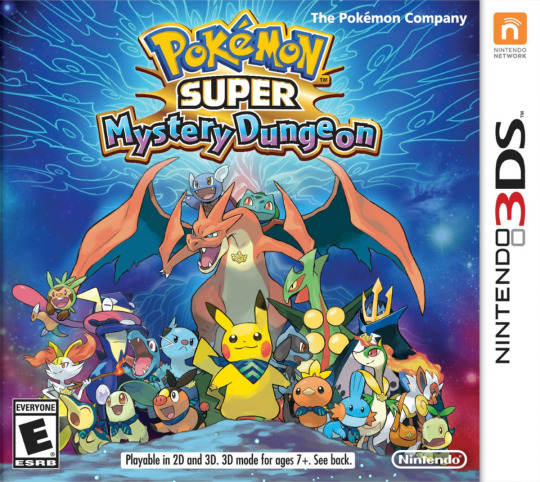
Well I’ve now beaten this game, and I have some thoughts about it, so chop chop Keara the story isn’t getting any younger I expect a full book report on my desk next Sunday.
Jokes aside, this was my first experience with a PMD game since Sky (discounting the demo for Gates to Infinity), and having missed the series’s third entry (fourth if you count those Japan-only WiiWare games), it’d be remiss of me not to at least mention that maybe some of the things I’m going to complain about were originally that game’s fault. But apparently that one actively sucks ass so who cares, just shift the blame over, eh?
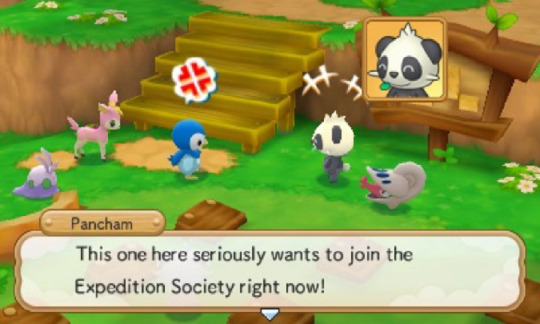
(ah, primary-school-tier bullying, exactly what I want in my Pokemon game, cool)
I think one of the foremost issues people have about PSMD is the story, and I can’t help but agree. The game spends what feels like forever fucking about in Serene Village, doing what could charitably described as tutorial followed by slice-of-life-ish plots, and while I love me a good slice-of-life anime, those tend to be a lot less slow than this. Also the characters tend to be a lot less one-note, but it’s a kids game, so whatever. Speaking of kids, this to my knowledge is the only PMD game where you and your partner character are canonically children, and spend a lot of time around others. The game seems to establish unevolved Pokemon as kids, which while it doesn’t really add up with the rest of the series (e.g. in the first ones, Caterpie is clearly a child, but Metapod is as well and Gulpin is at least adult enough to run their own store), it would ultimately be excusable if it didn’t make that huge section of the game so boring.
They aren’t consistent with that kids thing, by the way. When you finally reach the Expedition society, you’re met with a bunch of unevolved Pokemon (Archen, Buizel, Bunnelby, Swirlix) that are running around behaving very youthfully, who then turn around and go hey we don’t allow kids in our gang please leave. Like, the plot had been leading me to believe that the whole place was shut down, Ampharos as its final member, and those kids were just running around an abandoned building, but nope, here are your teammates for the rest of the game.
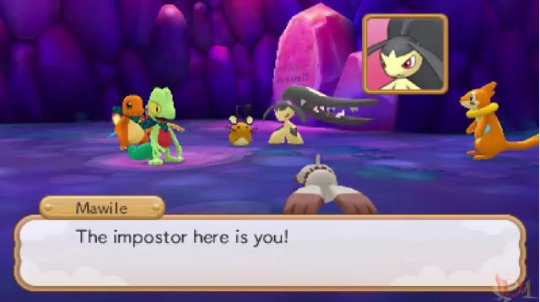
(brown sus)
The remainder of the plot is basically fine, its not like the plots in this series are the greatest on the planet (save maybe Explorers), though the focus on the villains turning people into stone felt pretty awkward. It’s like they wanted to pull off a more dramatic, more personal-stakesy plot but couldn’t actually kill anyone. This gets kind of egregious when you end up in actual hell for a bit, in what I guess is the series tradition of potentially traumatic experiences and blasted hellscapes being exposed to the protagonists. The endgame plot all seems to come at you at once, not helped by it being lots of chained dungeons without returning to towns beforehand- it wouldn’t be as bad if the whole game was like this, but with such a slow start, it just feels so inconsistent. The endgame twist was pretty spicy, I’ll admit, but it didn’t have enough buildup to feel earned in my honest opinion.
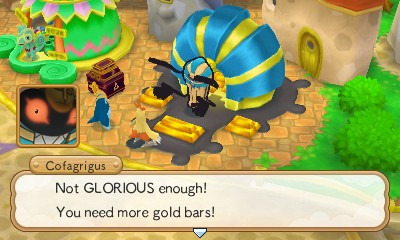
(pictured: the best character in the game)
But the plot doesn’t matter so much as the gameplay does it? And as someone who has also concurrently been playing through the first Pokemon Mystery Dungeon game on my GBA, there’s a lot of interesting comparisons to make. The dungeons on the whole are shorter in PSMD, with few of the main-game ones reaching beyond 10 floors (and not going much past it) compared to the prequels’ capping off with a 25+5 floor behemoth in Sky Tower. This is made up for by every floor of the dungeons in PSMD feeling much larger and more labyrinthine than anything in other PMD games, meaning each one takes much longer than you’d think. I dread to imagine what the 99-floor dungeons are like in this game, especially considering you now need an item to quicksave the game if you want to do anything else now. The dungeons themselves additionally really do not feel like they’ve taken advantage of the 9 years of potential design improvements and two console generations of technology improvements between games- it is frustratingly same-old same-old in the dungeon design.
These problems are capped off with the increased difficulty- that is, that every individual Pokemon is significantly more of a threat to you than in previous games, and you don’t really get the opportunity to level grind much. And I’m not opposed to difficulty in games, obviously, but what it does in PSMD is ruin the flow of the gameplay for me. What works in Mystery Dungeons previous was that blend of exploration and combat, and in Super, that gets completely broken up by protracted encounters with even the chump-tier mons you encounter along the way. Also, they made the basic attack complete shit, and I don’t like that.
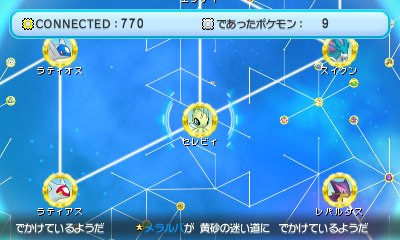
That’s not to say that the gameplay is all bad. I won’t comment too heavily on the Looplet/Emera system, because I’m kinda mid on it, but it didn’t help that despite all the game’s tutorialising I still didn’t get part of it until most of the way through the story. The game does have some moments of genuine brilliance in design, though. The way you recruit more Pokemon is so much better than the luck-based mission of the previous games, wihle managing to actually make you want to go on the random missions you get thrown throughout the game- for one thing they aren’t random, but it means you have a guaranteed good reward instead of the semi-RNG system where you just end up with a bunch of Gravelerocks and berries you’ll never use. In addition, the system where on non-plot days (and in the postgame) you just get 3 random Pokemon recommended to you, that get bonus EXP if you use them that day, is a great way of encouraging the player to diversify their Pokemon usage substantially, which is nice.

There’s a few other nice gameplay things I’d like to highlight. Considering the increased difficulty, the ability to rescue yourself (read: come back with the overpowered mons the game dropped in your lap) is really nice, especially since it’s not like anyone else is playing these games who can help. The way moves get better the more you use them is nice, especially considering how much more you use one move over and over in this game compared to main series Pokemon games. The random bonus missions and travelling mons you encounter in dungeons are nice, as well as the increased variety in missions available- as well as actually being able to revive fallen escortees, it makes the mission system overall much stronger than in previous entries.
Beyond that, though, I’m not sure what else I have to say about Super Mystery Dungeon. The game is a decent entry in what can barely be called a franchise these days, considering it’s 6 years old and yet still the newest entry, excluding the remake of the first ones that came out last year. It’d be a shame if this was the note we went out on for Pokemon Mystery Dungeon, but to be fair, I don’t think they’re ever going to be able to recapture the magic of the first two games. They struck gold with a lot of people, but I guess at this point, the gleam wore off.
4 notes
·
View notes
Note
Hii I'm new to the Fandom and I'm obsessed with your blog! I ADORE your point of view really its making me love star wars more and more, my question is do you have any recommendations on which books to read to understand more about the lore and where cannon is right now??
Hi! I’m glad if I can help you like SW lore more and thank you for such kind words, I deeply appreciate them. And, oh, what a tricky question that is, without meaning to be!A lot depends on which part of the SW lore you’re looking for–are you looking for technical terms or character backstory tidbits? Lore on Force woo? The stories that help better inform the structure of Star Wars? Because I feel like my answers would be different for each of those!So, I’m going to do a “here’s what I think is the best places to start when getting into SW supplementary material” list:1. THE TV SERIESIf you haven’t watched The Clone Wars and Rebels yet, those should be first on your list! TCW is there to help give you the bigger picture of just how awful the Clone Wars were, how politics dragged everything down into the mud, and will give you a ton of feelings on established characters. I’m currently in the middle of a rewatch and its kicking up all these feelings I had and you can really tell that this is what George Lucas’ world looks like when they have the time to explore it. (Though, hell, even with this show, it only covers things in broad strokes, especially because it is still aimed at younger audiences, too.)And Rebels is just a really great series by itself, but it also does a fantastic job of showing you just how complicated the war against the Empire was, how hard it was to wind together these various minor factions into one bigger Rebellion, as well as it does a lot to show what it’s like for Jedi after the genocide of their people. It also has some killer cameos and resolution to things started in TCW and moments of confrontation for all the characters.Both of those really only have minor moments of exploring the Force Woo Lore (but there’s really not one singular place that explains it, imo, it’s something you have to piece together to see the bigger picture), but they’re fantastic for echoing the narrative structure of Star Wars and its themes.2. THE COMICSThey’re the next best stop, they are also really great stories in terms of the character arcs, as well as the next best place to get more on the themes of Star Wars. There have been so many moments, more than anywhere else, that I have wanted to just absolutely (virtually) SCREAM, because HOLY SHIT THAT WAS A HELL OF A MOMENT or HOLY SHIT THAT UNDERSTOOD STAR WARS SO WELL or just had really amazing moments. I would recommend starting with:- The Star Wars 2015 comic (by Jason Aaron) and read it concurrently with Darth Vader vol. 1 (by Kieron Gillen), as they’re meant to go together.- Then read Darth Vader: Dark Lord of the Sith (by Charles Soule)- After that, in any order: Age of the Republic comics (by Jody Houser), Obi-Wan & Anakin (by Charles Soule), Jedi of the Republic - Mace Windu (by Matt Owens), and Kanan: The Last Padawan (by Greg Wiseman).- I also really enjoy the Star Wars Adventures comics from IDW, the Poe Dameron comics (by Charles Soul) are incredible and give a lot of context to the sequel trilogy and Shattered Empire does a lot in the same vein.3. THE NOVELSNovels are trickier, because some are good for lore but aren’t necessarily stories I would recommend to new fans, others are amazing stories but don’t necessarily have a lot of lore. So, I’m going to focus on the books that I think do the most bridge work and help you understand the bigger picture of Star Wars:- The Star Wars Battlefront II video game (okay, not a book, bear with me) does an amazing job of giving more context to how the Empire ended and how it connected to the First Order. You can do a search on YouTube for “Battlefront 2 game movie” or similar search parameters and watch it like a movie, it’s about two hours and it’s wonderful. Fall in love with the characters with me, understand why Jakku was important, and get some amazing cameos (and stunning planets) for the OT trio!- The Aftermath trilogy by Chuck Wendig also does a ton of showing how the Empire’s fall wasn’t instantaneous after Endor’s moon, as well as the faltering early steps of the New Republic, and a ragtag bunch who hunt down Imperial war criminals and all come to love each other AND I LOVE THEM, sobs. I would add in the caveat that I think these work massively better as audiobooks, so check if your library has them and maybe you can check them out on-line and be prepared to give the books a little time to grow on you.- Bloodline by Claudia Gray shows Leia six years before TFA and the New Republic still faltering and how she discovers the early origins of the First Order and loses her position in the Senate and starts up the Resistance. It’s at its best when it’s a Leia book, but it also does do a lot of groundwork for the connections between the OT and the ST!- From a Certain Point of View by various authors, is a collection of short stories, many of which are hits and many of which are misses, but the hits are amazing. If nothing else, “Master & Apprentice” (by Claudia Gray–not to be confused with the full novel of the same title), “Time of Death” (by Cavan Scott), “There Is Another” (by Gary D. Shmidt), and “An Incident Report” (by Daniel Mallory Ortberg) are all MUST READS. I read all of them and I’m glad I did, but if a story isn’t gripping you, feel free to skim over it for the next, they’re only connected by theme, not events.- I loved both Spark of the Resistance (by Justina Ireland) and Resistance Reborn (by Rebecca Roanhorse) as books set between TLJ and TROS, where I grew even more fond of the characters getting to have adventures together. I also thought the Dooku: Jedi Lost audiodrama was probably the best PT era canon book to recommend, too.4. THE GUIDEBOOKSGuidebooks are more fun when you’re already invested and just want to look up a thing or two, but there’s at least one that I think is a must-read from cover to cover: Star Wars Propaganda: A History of Persuasive Art in the Galaxy by Pablo Hidalgo. It doesn’t sound like it would be that interesting–a history told through art? But it’s an absolutely stellar bird’s eye view and explanation of how things happened in the GFFA, how the Clone Wars happened, how the Republic fell, how the Empire rose, how the Rebellion fought back, how the New Republic rose, how the First Order knocked it all down again.5. ANYTHING ELSE?I love the game Jedi: Fallen Order and I think it does an amazing job of staying true to the Jedi Order, their culture, and the themes of Star Wars. You can do the same thing of looking for a movie-version on YouTube, it should be about four hours long to cover the majority of the game, and I absolutely fell in love with the characters and the world, it was clear they really cared about the story and the lore and making this feel like a game where you got to experience becoming a Jedi.This isn’t a list of “stories I thought were good” but ones aimed at establishing the best understanding of the bigger galaxy, as well as stories that I thought were really good for new fans! While I put them generally in the order I would suggest them, if something’s not working for you, feel free to drop it and move on to another thing, either coming back later to the dropped one or not, because this should be fun and not boring work.HOPEFULLY THAT’S A GOOD PLACE TO GET YOU STARTED and if someone else would suggest a good Starting Place For A New Fan, feel free to chime in!
58 notes
·
View notes
Text
TerraMythos' 2020 Reading Challenge - Book 22 of 26
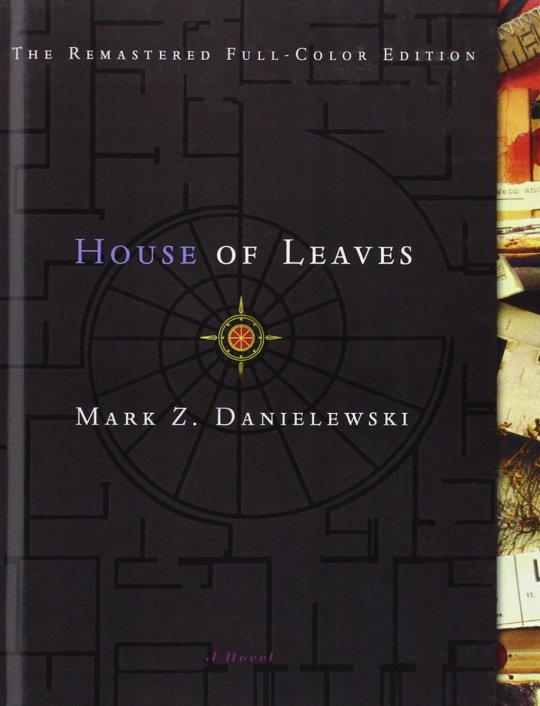
Title: House of Leaves (2000)
Author: Mark Z. Danielewski
Genre/Tags: Horror, Fiction, Metafiction, Weird, First-Person, Third-Person, Unreliable Narrator
Rating: 6/10
Date Began: 7/28/2020
Date Finished: 8/09/2020
House of Leaves follows two narrative threads. One is the story of Johnny Truant, a burnout in his mid-twenties who finds a giant manuscript written by a deceased, blind hermit named Zampanò. The second is said manuscript -- The Navidson Record -- a pseudo-academic analysis of a found-footage horror film that doesn’t seem to exist. In it, Pulitzer Prize-winning photojournalist Will Navidson moves into a suburban home in Virginia with his partner Karen and their two children. Navidson soon makes the uncomfortable discovery that his new house is bigger on the inside than it is on the outside. Over time he discovers more oddities -- a closet that wasn’t there before, and eventually a door that leads into an impossibly vast, dark series of rooms and hallways.
While Johnny grows more obsessed with the work, his life begins to take a turn for the worse, as told in the footnotes of The Navidson Record. At the same time, the mysteries of the impossible, sinister house on Ash Tree Lane continue to deepen.
To get a better idea try this: focus on these words, and whatever you do don’t let your eyes wander past the perimeter of this page. Now imagine just beyond your peripheral vision, maybe behind you, maybe to the side of you, maybe even in front of you, but right where you can’t see it, something is quietly closing in on you, so quiet in fact you can only hear it as silence. Find those pockets without sound. That’s where it is. Right at this moment. But don’t look. Keep your eyes here. Now take a deep breath. Go ahead and take an even deeper one. Only this time as you start to exhale try to imagine how fast it will happen, how hard it’s gonna hit you, how many times it will stab your jugular with its teeth or are they nails? don’t worry, that particular detail doesn’t matter, because before you have time to even process that you should be moving, you should be running, you should at the very least be flinging up your arms--you sure as hell should be getting rid of this book-- you won’t have time to even scream.
Don’t look.
I didn’t.
Of course I looked.
Some story spoilers under the cut.
Whoo boy do I feel torn on this one. House of Leaves contains some really intriguing ideas, and when it’s done right, it’s some of the best stuff out there. Unfortunately, there are also several questionable choices and narrative decisions that, for me, tarnish the overall experience. It’s certainly an interesting read, even if the whole is ultimately less than the sum of its parts.
First of all, I can see why people don’t like this book, or give up on it early (for me this was attempt number three). Despite an interesting concept and framing device, the first third or so of the book is pretty boring. Johnny is just not an interesting character. He does a lot of drugs and has a lot of (pretty unpleasant) sex and... that’s pretty much it, at least at the beginning. There’s occasional horror sections that are more interesting, where Johnny’s convinced he’s being hunted by something, but they’re few and far between. Meanwhile, the story in The Navidson Record seems content to focus on the relationship issues between two affluent suburbanites rather than the much more interesting, physically impossible house they live in. The early “exploration” sections are a little bit better, but overall I feel the opening act neglects the interesting premise.
However, unlike many, I love the gimmick. The academic presentation of the Navidson story is replete with extensive (fake) footnotes,and there’s tons of self-indulgent rambling in both stories. I personally find it hilarious; it’s an intentionally dense parody of modern academic writing. Readers will note early that the typographical format is nonstandard, with the multiple concurrent stories denoted by different typefaces, certain words in color, footnotes within footnotes, etc. House of Leaves eventually goes off the chain with this concept, gracing us with pages that look like (minor spoilers) this or this. This leads into the best part of this book, namely...
Its visual presentation! House of Leaves excels in conveying story and feeling through formatting decisions. The first picture I linked is one of many like it in a chapter about labyrinths. And reading it feels like navigating a labyrinth! It features a key “story”, but also daunting, multi-page lists of irrelevant names, buildings, architectural terms, etc. There are footnotes that don’t exist, then footnote citations that don’t seem to exist until one finds them later in the chapter. All this while physically turning the book or even grabbing a mirror to read certain passages. In short, it feels like navigating the twists, turns, and dead ends of a labyrinth. And that’s just one example -- other chapters utilize placement of the text to show where a character is in relation to others, what kind of things are happening around them, and so on. One chapter near the end features a square of text that gets progressively smaller as one turns the pages, which mirrors the claustrophobic feel of the narrative events. This is the coolest shit to me; I adore when a work utilizes its format to convey certain story elements. I usually see this in poetry and video games, but this is the first time I’ve seen it done so well in long-form fiction. City of Saints and Madmen and Shriek: An Afterword by Jeff VanderMeer, both of which I reviewed earlier this year, do something similar, and are clearly inspired by House of Leaves in more ways than one.
And yes, the story does get a little better, though it never wows me. The central horror story is not overtly scary, but eeriness suffices, and I have a soft spot for architectural horror. Even Johnny and the Navidsons become more interesting characters over time. For example, I find Karen pretty annoying and generic for most of the book, but her development in later chapters makes her much more interesting. While I question the practical need for Johnny’s frame story, it does become more engaging as he descends into paranoia and madness.
So why the relatively low rating? Well... as I alluded to earlier, there’s some questionable stuff in House of Leaves that leaves (...hah?) a bad taste in my mouth. The first is a heavy focus on sexual violence against women. I did some extensive thinking on this throughout my read, but I just cannot find a valid reason for it. The subject feels thrown in for pure shock value, and especially from a male author, it seems tacky and voyeuristic. If it came up once or twice I’d probably be able to stomach this more easily, but it’s persistent throughout the story, and doesn’t contribute anything to the plot or horror (not that that would really make it better). I’m not saying books can’t have that content, but it’s just not explored in any meaningful way, and it feels cheap and shitty to throw it in something that traumatizing just to shock the audience. It’s like a bad jump scare but worse on every level. There’s even a part near the end written in code, which I took the time to decode, only to discover it’s yet another example of this. Like, really, dude?
Second, this book’s portrayal of mental illness is not great. (major spoilers for Johnny’s arc.) One of the main things about Johnny’s story is he’s an unreliable narrator. From the outset, Johnny has occasional passages that can either be interpreted as genuine horror, or delusional breaks from reality. Reality vs unreality is a core theme throughout both stories. Is The Navidson Record real despite all evidence to the contrary? Is it real as in “is the film an actual thing” or “the events of the film are an actual thing”? and so on and so forth. Johnny’s sections mirror this; he’ll describe certain events, then later state they didn’t happen, contradict himself, or even describe a traumatic event through a made-up story. Eventually, the reader figures out parts of Johnny’s actual backstory, namely that when he was a small child, his mother was institutionalized for violent schizophrenia. Perhaps you can see where this is going...
Schizophrenia-as-horror is ridiculously overdone. But it also demonizes mental illness, and schizophrenia in particular, in a way that is actively harmful. Don’t misunderstand me, horror can be a great way to explore mental illness, but when it’s done wrong? Woof. Unfortunately House of Leaves doesn’t do it justice. While it avoids some cliches, it equates the horror elements of Johnny’s story to the emergence of his latent schizophrenia. This isn’t outwardly stated, and there are multiple interpretations of most of the story, but in lieu of solid and provable horror, it’s the most reasonable and consistent explanation. There’s also an emphasis on violent outbursts related to schizophrenia, which just isn’t an accurate portrayal of the condition.
To Danielewski’s credit, it’s not entirely black and white. We do see how Johnny’s descent into paranoia negatively affects his life and interpersonal relationships. There’s a bonus section where we see all the letters Johnny’s mother wrote him while in the mental hospital, and we can see her love and compassion for him in parallel to the mental illness. But the experimental typographical style returns here to depict just how “scary” schizophrenia is, and that comes off as tacky to me. I think this is probably an example of a piece of media not aging well (after all, this book just turned 20), and there’s been a definite move away from this kind of thing in horror, but that doesn’t change the impression it leaves. For a book as supposedly original/groundbreaking as this, defaulting to standard bad horror tropes is disappointing. And using “it was schizophrenia all along” to explain the horror elements in Johnny’s story feels like a cop-out. I wish there was more mystery here, or alternate interpretations that actually make sense.
Overall The Navidson Record part of the story feels more satisfying. I actually like that there isn’t a direct explanation for everything that happens. It feels like a more genuine horror story, regardless of whether you interpret it as a work of fiction within the story or not. There’s evidence for both. Part of me wishes the book had ended when this story ends (it doesn’t), or that the framing device with Johnny was absent, or something along those lines. Oh well-- this is the story we got, for better or worse.
I don’t regret reading House of Leaves, and it’s certainly impressive for a debut novel. If you’re looking for a horror-flavored work of metafiction, it’s a valid place to start. I think the experimental style is a genuine treat to read, and perhaps the negative aspects won’t hit you as hard as they did to me. But I can definitely see why this book is controversial.
7 notes
·
View notes
Note
🍪 take a cookie because you deserve it :),, also please tell me about geralt and yennifer and also is the witcher easy to watch without knowing much about the source material ???
I watched three episodes of Witcher with zero context whatsoever, understood everything, enjoyed it hugely, read about 200K of fic, watched three more episodes, read the first book in the series, and finished the show. As long as you are prepared for the fact that, A, the timelines of the three main characters converge, they are not concurrent, and, B, it’s not Game of Thrones and it’s not trying to be Game of Thrones, you will be ABSOLUTELY fine.
(Do critics just…not use critical thinking skills? Half of everyone I’ve talked to said that this show was impossible to follow. It is not impossible to follow. Yennefer and Geralt are just really old. Also, everyone and their cousin is like “well it’s not GoT” yeah???? Obviously???? “This isn’t chili” “No, it’s chicken pot pie” “I wanted chili” “Then go have some chili I guess??? This is chicken pot pie. Still a food, just not that food.” It’s not Game of Thrones. If you want Game of Thrones, go watch that instead, or read the books, or maybe watch some Avatar and calm down. Stop crucifying every fantasy product for not being Game of Thrones II.)
TL;DR: Yeah dude you’ll be totally fine, watch this show. And then if you don’t mind spoilers for the rest of the (book and game) series, read Astolat’s Witcher fic.
ANYWAY
Geralt and Yennefer. This got…very long.
Here’s the fairly unique emotion I’m feeling about this relationship: I think it’s absolutely in-character and believable, I’m completely convinced that Geralt and Yennefer would end up together, and I am equally convinced that their relationship has a pretty hard expiration date on it. I’m not sure I’ve ever actually been interested in a relationship dynamic that I took one look at and went “oh, wow, this is going to break down hard the second your need to help people even when they hate you and her need to get revenge on people who hate her are in conflict.” That’s very novel for me, because normally I like endgame relationships. I find breakup drama exhausting. I have dumped two people ever and both times I was very nice for ten minutes and then very short-tempered for the rest of the conversation.
But I’m really invested in the breakdown here. And I’m really invested in how completely inevitable the relationship is, despite what I consider to be the equally inevitable calamitous breakup.
The thing is, Geralt has lived his entire life as a witcher, which means that the world is divided into two groups for him: people who are dependent on him as a witcher, and people who hate and fear him as a witcher. (There are also Other Witchers, but with so few of them left that they fall pretty heavily into the ‘people who depend on him’ category.) There is a not-inconsiderable amount of overlap in that Venn diagram, but that’s pretty much how it is on this bitch of a Continent. The people who Geralt is drawn to, in whatever context, tend to be the rare handful who fall outside that binary metric in some way.
Renfri could use help from him, but she’s more than able to handle herself. In fact, when the chips are down, her final gamble is to just remove him from the field of play, and try to resolve the situation alone.
Triss needs him in a professional capacity, but she brings just as much to the table as he does, both in terms of political knowledge about the striga situation and in terms of dragging his battered ass out of the castle before he can quietly bleed out. She’s not looking for a rescuer, she’s looking for a tank to complement her glass cannon.
Jaskier needs Geralt to save him (in the show)…but only because he was usually the one to get them into trouble in the first place. And he sticks around once he’s been saved, once he isn’t depending on Geralt to get him out alive anymore.
Even Ciri, who is absolutely dependent on him in a very literal and legal sense, is distinctly different from the general populace, who need a witcher to pull them out of trouble. She’s one of probably very few people who’s ever been dependent on Geralt as a person, rather than a hired killer. Sure, it’s helpful that he can kill anyone who looks crooked at her, but she also needs to eat, and to learn to use a sword, and to be trained in things like magic and languages, and all the things that a kid needs from a parent. That’s radically different from Geralt’s experience of being depended on as a witcher.
But Yennefer…Yennefer doesn’t need Geralt. She’s not dependent on Geralt. She’s not afraid of Geralt in any way, let alone just because he’s a witcher–in fact, she barely seems to notice that he’s a witcher, except in the way that it makes them alike. Geralt’s taste in partners is obviously “people who are not afraid of him” with very few other requirements, and Yennefer is a powerful mage, someone who would be able to take down a witcher without difficulty. She’s also well-educated, very clever, and completely fearless about the world in general. That’s everything Geralt finds compelling, all with the added bonus of an extremely pretty face. It makes complete narrative sense that Geralt is in love with her.
Incidentally I do not believe that Geralt wished for Yennefer to be in love with him, because it wouldn’t track with the rest of his character and would be a level of vulnerability he works hard to avoid. I do believe that he might have said something rash like “I wish I wouldn’t lose her” and now they are here. It’s important to think your wishes through when dealing with an angry wish-granting being.
On Yennefer’s end of things, she has only ever wanted two things: to be respected and to be wanted. In any capacity that might be available to her. I think this is really the major driving force of her desire to have children–she’s not overwhelmingly interested in children as a phenomenon, and I think that in another life she wouldn’t want them. But she said it herself, she wants a child because she always wanted to be important to someone. It’s not about the kid. She’s obsessed with the idea that she will always be important to a child. A child would be completely dependent on her, completely devoted to her, no matter what.
(Side note: this is a bad reason to have kids! Geralt is right and she would be a bad mother. She’s also obsessed with having kids because she can’t handle the revelation that she’s not happy with the deal she made, and she’s focused all that discontent into the literal, tangible loss of being able to carry a child. But “Yennefer actually probably does not want a child and is rampantly projecting all her issues onto the most readily available problem she can find” is a separate post. Probably the first pregnancy-centric plotline I’ve ever been able to handle without feeling violently dysphoric, though.)
The thing is, when she meets Geralt during the djinn fiasco, he needs her. He’s dependent on her. She’s important to him because of what she can do for him, which is how she’s set up her life. When he comes back to save her, though, he’s not doing it for payment, or for a favor, or for any of the other clean, linear exchanges that Yennefer is used to. He just…comes back. For her. Because she’s a person.
Yennerfer has never been important just as…a person, before. She’s important as a mage, she’s important as a student, she’s important as a project or a protector. But from the second Geralt comes back for her, she’s important to him as a person. The fact that almost any person would be on the level of “important enough to save from a rampaging djinn and their own stupidity” to Geralt is completely superfluous to how hard that hits Yennefer. Of course she’s in love with him. Of course she keeps looking for him, keeps pouring on the charm whenever she’s with him–she wants him to keep wanting her. Because that’s how she knows to make herself important to someone, is to make them want her.
(This is also where it gets interesting with Ciri, because…well, if Yennefer really just wanted kids, she could do worse than the news of the girl who’s Geralt’s daughter in the eyes of the law. But she’s furious, because her views of family are intensely skewed and limited by her experiences. Also a separate post that I will probably make after reading some more of the books.)
Regarding the inevitably dramatic breakdown of their relationship (beyond the falling out over the djinn thing, which, see above), I think they’re under the impression that if they do it right, they could stand the test of time. They’re both extremely long-lived, so the test of time has the potential to be a while, but I frankly don’t think they’d make it outside of a conflict-heavy environment (like, say, a war). When they have a mutual goal, or at least a mutual enemy, Geralt and Yennefer work together like a right and left hand. When they do not, they fall apart something fierce, because they’re driven by intrinsically different motives. Geralt, for all that he tries to be as cynical as possible, has been trained his entire life to protect people, and considers it a worthwhile goal in and of itself. Yennefer, on the other hand, is as innately self-motivated as Geralt pretends to be, which means that she’s driven heavily by what feels best for her in the moment. Sometimes that means healing a wounded bard and talking quietly with a witcher about their mutual scars! Sometimes that means leaving a woman to die for calling her a worthless bitch! This is a morally neutral statement that I’m making, there’s a generous and an ungenerous way to read Yen’s decisions, but I think we can agree that she’s not exactly following a rulebook here. Yennefer has her goals and she’s going to achieve them, and fuck you for getting in her way.
Including Geralt.
I think that, virtually without question, Yennefer’s self-oriented hedonistic drive and Geralt’s protection-based code will clash, and their relationship will break down in spectacular fireworks. Having to self-determine, during peace time, is practically guaranteed to bring those two motivating factors into conflict eventually. Because during peace time, Geralt will be back to being the hated witcher and Yennefer won’t have a better enemy to focus on than the civilians he risks his life for on the regular. And Geralt demonstrably does not respond well to that.
#the witcher#witcher#netflix witcher#geralt of rivia#yennefer of vengerberg#geralt x yennefer#...sort of#starlight writes stuff#anyway yes i am fascinated and also absolutely convinced of the fact that their relationship will eventually go supernova#this is actually only a fraction of my thoughts on the subject as evidenced by my plethora of parentheticals#but it got so long that i had to shut up and go to bed#i didn't even get into my weird emotional state on yennefer#i don't like her much! ...MOST of the time!#when she's around geralt i really genuinely like her as a person#and that GLARING difference is really interesting to me#because it doesn't scan as completely manipulative i think she really does care for him#but she's also showing him SUCH an incredibly different side of herself that he would be denounced as a liar if he ever mentioned it#i think she's really latched onto their shared magical mutation with the assumption that he's as angry as she is#and it causes her to show him a whooooole other self#i'm fascinated#i do not believe they would work out and i don't think it would be good for them (esp geralt) if they tried#but i am fascinated#my gf bought me witcher 3 and i've been reading the books so it's safe to say that i have more comments#jothjimbo#asked and answered#a queue we shall keep and our honor someday avenge
44 notes
·
View notes